Paul van Yperen's Blog, page 383
May 6, 2015
Senta Söneland
Dark-haired Senta Söneland (1882-1933) was a German comic actress whose peaks in her film career were in the later 1910s and the early 1930s.
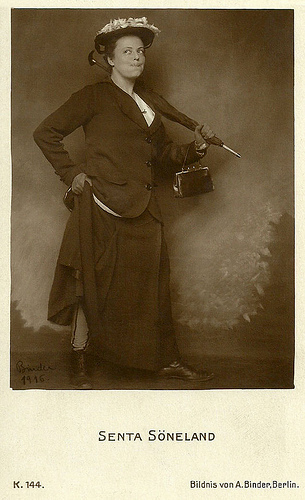
German postcard no. K 144. Photo: A. Binder, Berlin, 1916.
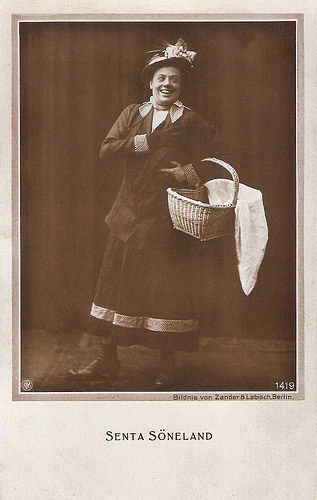
German postcard by NPG, no. 1419. Photo: Zander & Labisch, Berlin.
Contract Clause
Senta Söneland was born as Else Bertha Sophie Adele Werder in Diedenhofen, Germany (now Thionville, France) in 1882. She was the daughter of a Prussian regimental commander. Senta started her career as a school teacher, but she also took acting lessons at the Schiller Theater.
In 1911 (some sources say 1910), she went to work at the Hoftheater Meiningen, and she specialized in comedy. In 1912 she returned to Berlin and performed at the Komödienhaus, at the Theater am Kurfürstendamm and at the Metropol-Theater.
She had a clause in her contract not to work for film, because of its bad reputation. Despite the clause, she went over to the cinema during the First World War, when the German theatre world imploded.
Between 1915 and 1919 Söneland was a popular screen comedienne with films like Der Onkel aus Amerika/The Uncle from America (Hans Hyan, 1915), Benjamin, der Schüchterne/Bashful Benjamin (William Karfiol, 1915) with Reinhold Schünzel , and Der Gattestellvertreter/The Representative of the Husband (Adolf Gartner, 1918) with Bruno Kastner .
She even had her own film series, with such titles as 'Senta as...'. In all these films she played the female lead. In addition she played supporting roles in such comedies as Pension Lampel (Max Mack, 1915) starring Hanni Weisse .
Söneland became politically active for the right of women to vote. In 1919, she held a fiery speech at the Berlin Zoo Station in front of hundreds of people on the occasion of the election for the National Assembly.
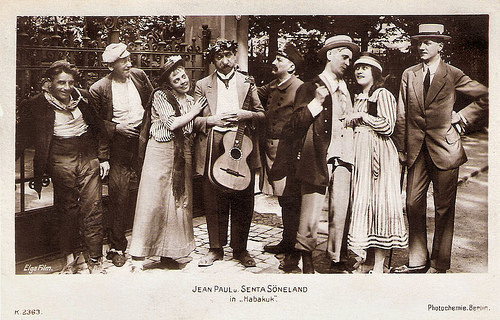
German postcard by Photochemie, Berlin, no. K. 2363. Photo: Elga Film. Publicity still for Habakuk (Franz Schmelter, 1918) with Jean Paul.
Comical Sidekicks
In the 1920s Senta Söneland did just two films and focused on the stage. Between 1923 and 1925 Söneland was a member of the Berlin Apollo Theater.
When sound cinema set in, Söneland returned to the screen and did many films in the early 1930s. She had major parts in Der Weg nach Rio/The Road to Rio (Manfred Noa, 1930), Reserve hat Ruh/Reserve has Rest (Max Obal, 1931), and Die Bräutigamswitwe/The bridegroom's widow (Richard Eichberg, 1931).
But she more often played minor parts now, as the comical sidekicks in Susanne macht Ordnung/Susanne does order (Eugen Thiele, 1930) starring Truus van Aalten , Der unbekannte Gast/The Unknown Guest (E.W. Emo) starring Szöke Szakall , and Hasenklein kann nichts dafür/Hasenklein Can Do Nothing For It (Max Neufeld, 1933) with Jakob Tiedtke and Lien Deyers .
Söneland also played herself in the filmed musical medleys Wiener Wald/Viennese forest (Günther Schwenn, 1931), Der Durchschnittsmann/The Average man (Gert Bendel, a.o., 1931), and Das Publikum singt mit/The Public Sings Along (1931); often with The Comedian Harmonists.
Since 1912, she was married with the former officer and later director of the Horch, Karl Ernst Krocker. He suddenly died in late 1933 as the result of an operation. After the death of her husband, she retired from the stage.
In 1934 Senta Söneland committed suicide. She could not cope mentally with the sudden loss of her husband, but she also feared the Nazi regime because of her Jewish ancestry. Söneland was 51.
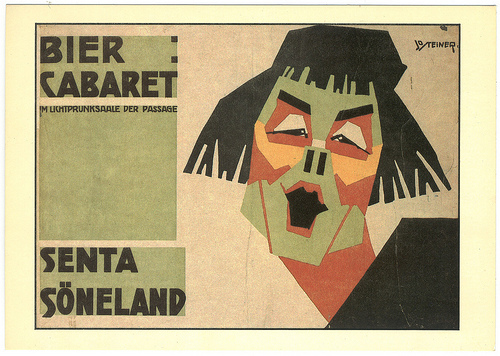
Advertisment by Jo Steiner, 1912. Collection: Performing Arts / Artes Escénicas'.
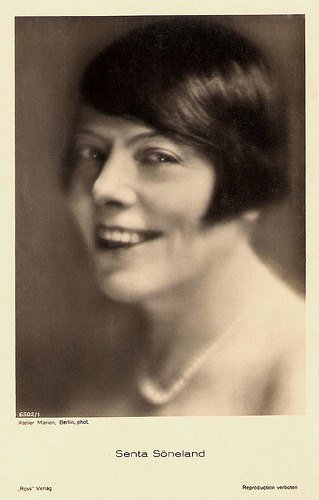
German postcard by Ross Verlag, no. 6502/1, 1931-1932. Photo: Atelier Marion, Berlin.
Sources: Stephanie D'heil (Steffi-line - German), Thomas Staedeli (Cyranos), Die Frau im Film 1919, Filmportal.de, Wikipedia (German) and .

German postcard no. K 144. Photo: A. Binder, Berlin, 1916.

German postcard by NPG, no. 1419. Photo: Zander & Labisch, Berlin.
Contract Clause
Senta Söneland was born as Else Bertha Sophie Adele Werder in Diedenhofen, Germany (now Thionville, France) in 1882. She was the daughter of a Prussian regimental commander. Senta started her career as a school teacher, but she also took acting lessons at the Schiller Theater.
In 1911 (some sources say 1910), she went to work at the Hoftheater Meiningen, and she specialized in comedy. In 1912 she returned to Berlin and performed at the Komödienhaus, at the Theater am Kurfürstendamm and at the Metropol-Theater.
She had a clause in her contract not to work for film, because of its bad reputation. Despite the clause, she went over to the cinema during the First World War, when the German theatre world imploded.
Between 1915 and 1919 Söneland was a popular screen comedienne with films like Der Onkel aus Amerika/The Uncle from America (Hans Hyan, 1915), Benjamin, der Schüchterne/Bashful Benjamin (William Karfiol, 1915) with Reinhold Schünzel , and Der Gattestellvertreter/The Representative of the Husband (Adolf Gartner, 1918) with Bruno Kastner .
She even had her own film series, with such titles as 'Senta as...'. In all these films she played the female lead. In addition she played supporting roles in such comedies as Pension Lampel (Max Mack, 1915) starring Hanni Weisse .
Söneland became politically active for the right of women to vote. In 1919, she held a fiery speech at the Berlin Zoo Station in front of hundreds of people on the occasion of the election for the National Assembly.

German postcard by Photochemie, Berlin, no. K. 2363. Photo: Elga Film. Publicity still for Habakuk (Franz Schmelter, 1918) with Jean Paul.
Comical Sidekicks
In the 1920s Senta Söneland did just two films and focused on the stage. Between 1923 and 1925 Söneland was a member of the Berlin Apollo Theater.
When sound cinema set in, Söneland returned to the screen and did many films in the early 1930s. She had major parts in Der Weg nach Rio/The Road to Rio (Manfred Noa, 1930), Reserve hat Ruh/Reserve has Rest (Max Obal, 1931), and Die Bräutigamswitwe/The bridegroom's widow (Richard Eichberg, 1931).
But she more often played minor parts now, as the comical sidekicks in Susanne macht Ordnung/Susanne does order (Eugen Thiele, 1930) starring Truus van Aalten , Der unbekannte Gast/The Unknown Guest (E.W. Emo) starring Szöke Szakall , and Hasenklein kann nichts dafür/Hasenklein Can Do Nothing For It (Max Neufeld, 1933) with Jakob Tiedtke and Lien Deyers .
Söneland also played herself in the filmed musical medleys Wiener Wald/Viennese forest (Günther Schwenn, 1931), Der Durchschnittsmann/The Average man (Gert Bendel, a.o., 1931), and Das Publikum singt mit/The Public Sings Along (1931); often with The Comedian Harmonists.
Since 1912, she was married with the former officer and later director of the Horch, Karl Ernst Krocker. He suddenly died in late 1933 as the result of an operation. After the death of her husband, she retired from the stage.
In 1934 Senta Söneland committed suicide. She could not cope mentally with the sudden loss of her husband, but she also feared the Nazi regime because of her Jewish ancestry. Söneland was 51.

Advertisment by Jo Steiner, 1912. Collection: Performing Arts / Artes Escénicas'.

German postcard by Ross Verlag, no. 6502/1, 1931-1932. Photo: Atelier Marion, Berlin.
Sources: Stephanie D'heil (Steffi-line - German), Thomas Staedeli (Cyranos), Die Frau im Film 1919, Filmportal.de, Wikipedia (German) and .
Published on May 06, 2015 22:00
May 5, 2015
Neue Photographische Gesellschaft (NPG)
Neue Photographische Gesellschaft (NPG) was the first and for years the world’s biggest factory for real photographic bromide postcards, which were printed ‘by the kilometre’. The founder and driving force was Arthur Schwarz (1862-1944), who travelled various countries, established contacts and gained knowledge.
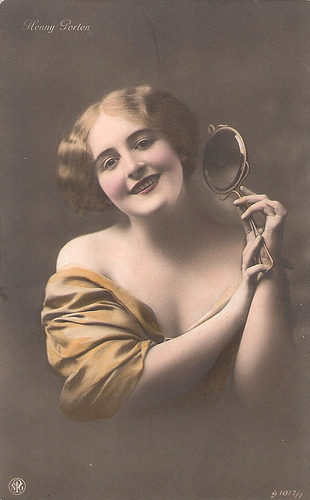
Henny Porten . German postcard by NPG (Neue Photographische Gesellschaft), no. G 1017/1.
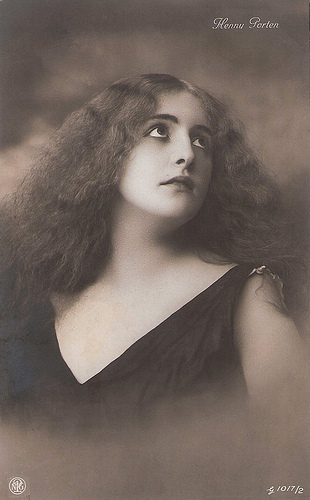
Henny Porten . German postcard by NPG, no. G 1017/2.
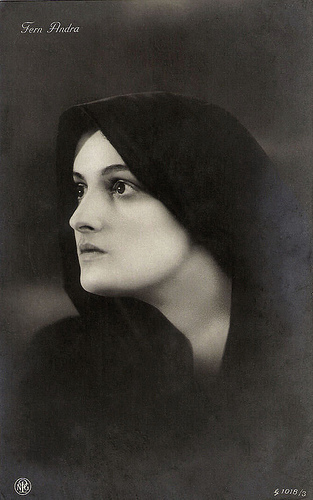
Fern Andra . German postcard by NPG, no. G 1018/3.
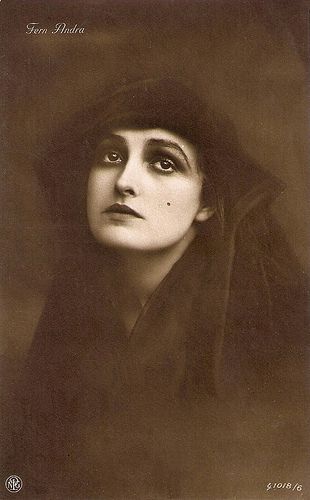
Fern Andra . German postcard by NPG, no. 1018/6.
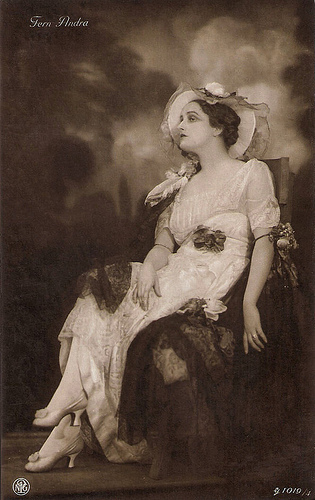
Fern Andra . German postcard by NPG, no. G 1019/4.
More than 40,000 postcards a day
The New Photographic Society was a member organisation of photographers founded by Arthur Schwarz. He founded the NPG in July 1894 in Berlin-Schöneberg and the 35 members turned the group into a Limited Corporation (in German: AG).
The members published many real photo postcards and stereo-views, and they manufactured photo paper as well. The majority of the offered cards were bromide real photo cards, the others done by (copper) gravure process.
The NPG developed the use of photosensitive bromide silver paper in rotation. They were the first company who used photographic paper in roll form, thus simplifying the mass production of photographs. The NPG was called the inventor of the ‘km photography’.
Arthur Schwarz travelled to 60 cities in 75 days, in Canada, Mexico, Russia, Greece, Italy, France, etc. In these cities he established contacts and gained experience and knowledge. These trips were the basis for the establishment of subsidiaries in 1890 in London and 1892 in New York.
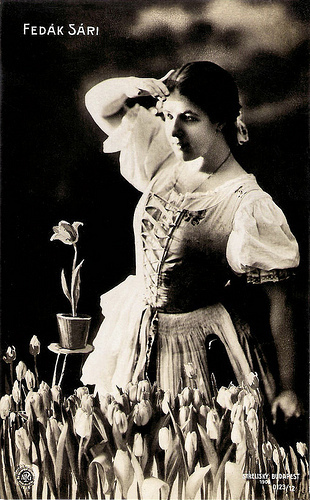
Sá ri Fedák . Hungarian postcard by NPG, no. 0123/12, 1906. Photo: Strelisky, Budapest.
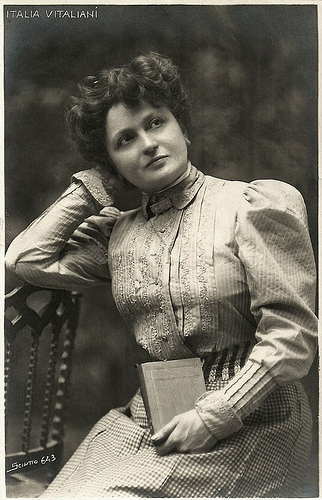
Italia Vitaliana . Italian postcard by NPG, no. 643. Photo: Sciutto. Gigi Sciutto was a famous Genovese photographer in the early 1900s. He supposedly shot the first film footage on Genova around 1897.
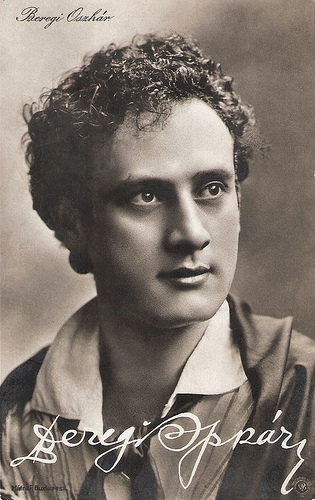
Oscar Beregi Sr. Hungarian postcard by NPG. Photo: Mátrai, Budapest.
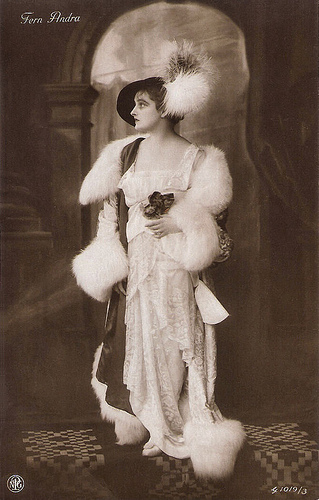
Fern Andra . German postcard by NPG, no. G 1019/3.
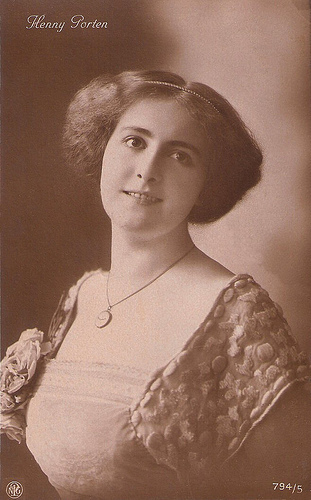
Henny Porten . German postcard by NPG, no. 794/5. Sent by mail in the Netherlands in 1921.
Minimizing the competition
Backbone of the NPG success were machines used for photographic paper and printing constructed after US patents but improved. The machines automatically operated exposure and accelerated the process and solved the photo production from having to use glass plates. In one day more than 40,000 postcards could be produced. The NPG machines were built to last and some were in use for over 60 years.
Thanks to the various NPG patents registered between 1895-97 for many countries, Arthur Schwarz was in the position to minimize competition. In 1904 she had 650 employees, a few years later circa 1,200. NPG had branches and associated partner companies in London, New York, Paris, Vienna, Brussels, Milano etc.
They also printed real photo cards for other companies such as Rotograph and became the largest manufacturer of bromide postcards in the world. As demand for postcards grew they started publishing artist signed cards as tinted halftones.
NPG played a leading role, not only as photographic printer but also as publisher of thousands of postcards, stereo cards etc. Subjects for the postcards were the Kaiser and the Hohenzollern family, militaries, sculptures, and soon also actors. The first German film stars, like Henny Porten and Fern Andra , became popular subjects.
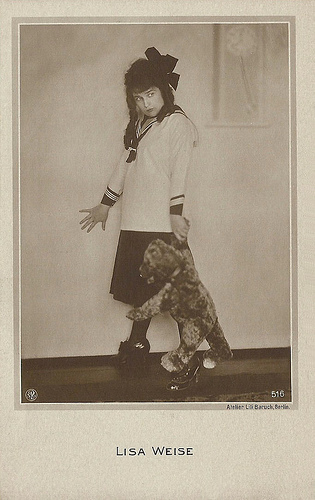
Lisa Weise . German postcard by NPG, no. 516. Photo: Lili Baruch, Berlin. Collection: Didier Hanson.
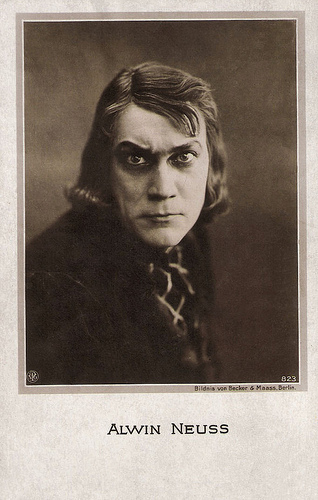
Alwin Neuss. German postcard by NPG, no. 823. Photo: Becker & Maass, Berlin.
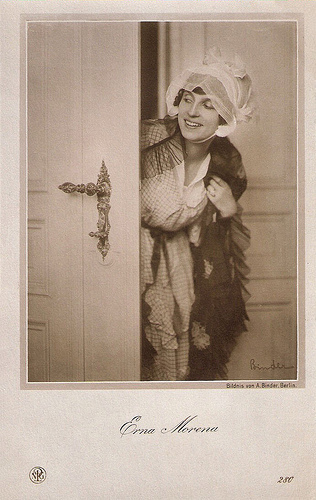
Erna Morena . German postcard by NPG, no. 280. Photo: Alex Binder, Berlin.
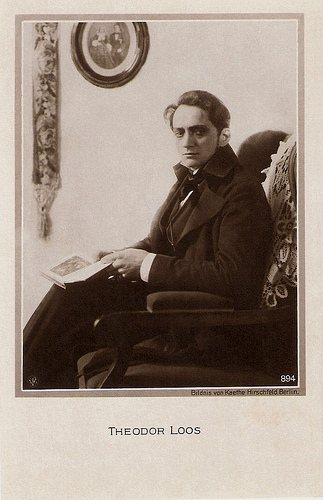
Theodor Loos. German postcard by NPG, no. 894. Photo: Käthe Hirschfeld, Berlin.
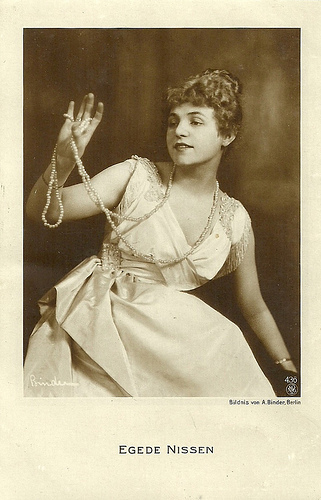
Aud Egede Nissen . German postcard by NPG, no. 436. Photo: Alex Binder, Berlin.
Social enterprise
The NPG was characterized by a social enterprise culture. For the employee was a company health insurance set up, granted to employees in addition to free medical treatment and medicine sick pay. In addition, there was a life insurance policy on the basis of a bonus system and Christmas bonuses for all employees, which amounted to a total of 20,000 marks in 1903.
A fire brigade of 37 men provided security at the factory and the company's own casino supplied in its dining room 36 meters long and 14 meters wide, the employees with food and drinks at cost price. The female staff was granted a free lunch. A reading room with newspapers and a stage for performances and presentations provided for the welfare of the employees.
Between 1910 and 1912, the basics of color photography were developed by the chemist Rudolf Fischer and his collaborator Hans Sigrist in the laboratories of the NPG. However, the colour photography process was never really ready for the market.
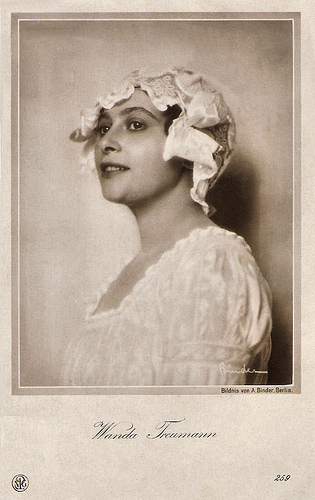
Wanda Treumann . German postcard by NPG, no. 259. Photo: Alex Binder, Berlin.
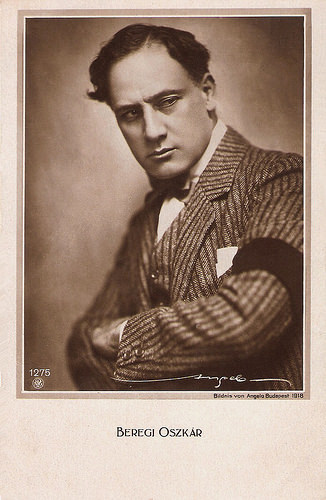
Oscar Beregi Sr. German postcard by NPG, no. 1275 Photo: Angelo, Budapest, 1918.
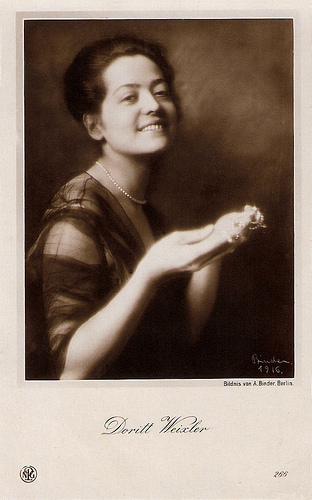
Dorrit Weixler . German postcard by NPG, no. 266. Photo: Alex Binder, 1916.
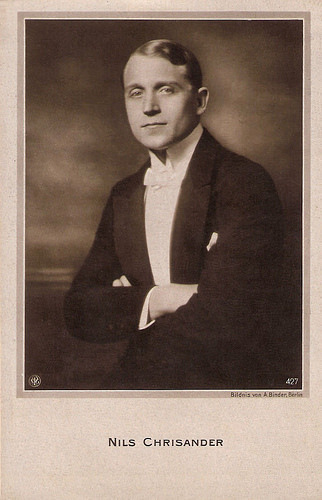
Nils Chrisander . German postcard by NPG, no. 427. Photo: Alex Binder.
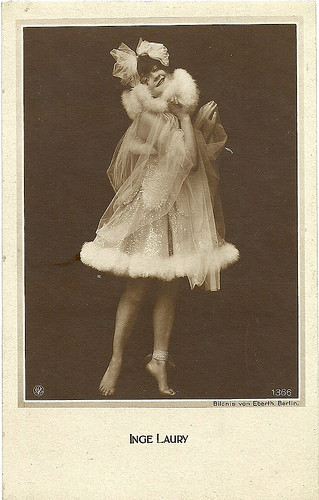
Inge Laury. German postcard by NPG, no. 1366. Photo: Eberth, Berlin. Collection: Didier Hanson.
Colour photography process
Arthur Schwarz had to leave his company in 1913. In 1921 a new NPG GmbH (Ltd) company was set up. Mimosa AG Dresden had bought shares of NPG already in 1920. The decline of the postcard boom, WW1, but also some mismanagement and the failed introduction of the colour photography process never really ready for the market, meant the end of the old company.
Local competitor E.A. Schwerdtfeger AG took over the NPG trademark and postcard department, who continued producing their cards until the Second World War.
The newly formed NPG Ltd. was in business until 1948. It stayed for many years in Berlin, and then moved to Dresden.
Neue Photographische Gesellschaft (NPG) had a variety of logo’s registered. The regular NPG logo is around in several designs and in all the film star postcards in this post.
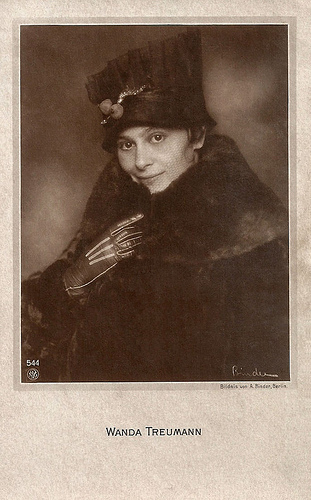
Wanda Treumann . German postcard by NPG, no. 544. Photo: Alex Binder, Berlin.
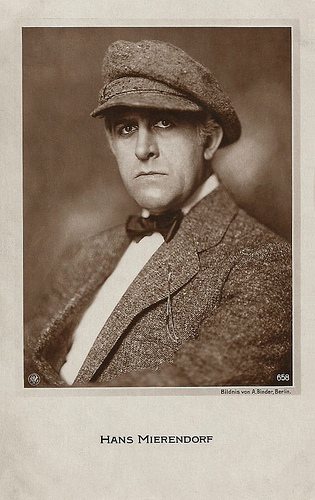
Hans Mierendorff . German postcard by NPG, no. 658. Photo: Alex Binder, Berlin.
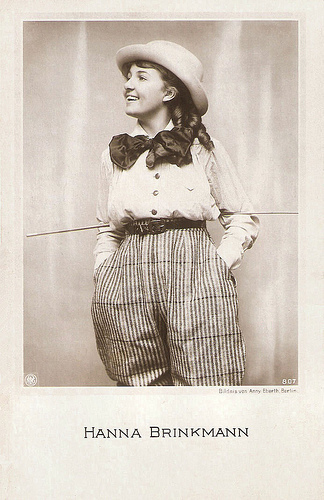
Hanne Brinkmann . German postcard by NPG, no. 807. Photo: Anny Eberth, Berlin.
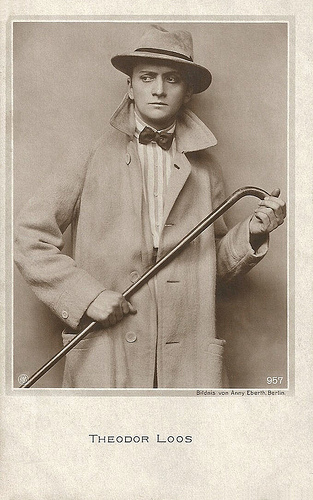
Theodoor Loos . German postcard by NPG, no. 957. Photo: Anny Eberth, Berlin.
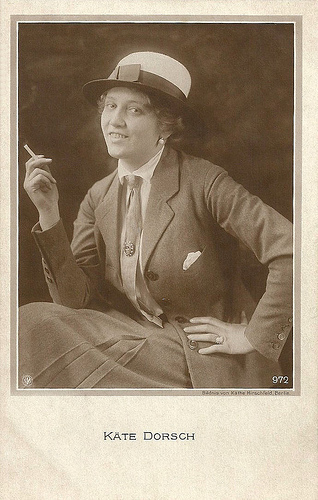
Käthe Dorsch . German postcard by NPG (Neue Photographische Gesellschaft), no. 972. Photo: Käthe Hirschfeld, Berlin.
This was the eighth post in a series on film star postcard publishers. Next week: Kwatta. For earlier posts, see the links at right under the caption 'The Publishers'.
Sources: Wolfgang Holtz (Neue Photografische Gesellschaft Steglitz – German), The Postcard Album, Metropostcard and Wikipedia (German).

Henny Porten . German postcard by NPG (Neue Photographische Gesellschaft), no. G 1017/1.

Henny Porten . German postcard by NPG, no. G 1017/2.

Fern Andra . German postcard by NPG, no. G 1018/3.

Fern Andra . German postcard by NPG, no. 1018/6.

Fern Andra . German postcard by NPG, no. G 1019/4.
More than 40,000 postcards a day
The New Photographic Society was a member organisation of photographers founded by Arthur Schwarz. He founded the NPG in July 1894 in Berlin-Schöneberg and the 35 members turned the group into a Limited Corporation (in German: AG).
The members published many real photo postcards and stereo-views, and they manufactured photo paper as well. The majority of the offered cards were bromide real photo cards, the others done by (copper) gravure process.
The NPG developed the use of photosensitive bromide silver paper in rotation. They were the first company who used photographic paper in roll form, thus simplifying the mass production of photographs. The NPG was called the inventor of the ‘km photography’.
Arthur Schwarz travelled to 60 cities in 75 days, in Canada, Mexico, Russia, Greece, Italy, France, etc. In these cities he established contacts and gained experience and knowledge. These trips were the basis for the establishment of subsidiaries in 1890 in London and 1892 in New York.

Sá ri Fedák . Hungarian postcard by NPG, no. 0123/12, 1906. Photo: Strelisky, Budapest.

Italia Vitaliana . Italian postcard by NPG, no. 643. Photo: Sciutto. Gigi Sciutto was a famous Genovese photographer in the early 1900s. He supposedly shot the first film footage on Genova around 1897.

Oscar Beregi Sr. Hungarian postcard by NPG. Photo: Mátrai, Budapest.

Fern Andra . German postcard by NPG, no. G 1019/3.

Henny Porten . German postcard by NPG, no. 794/5. Sent by mail in the Netherlands in 1921.
Minimizing the competition
Backbone of the NPG success were machines used for photographic paper and printing constructed after US patents but improved. The machines automatically operated exposure and accelerated the process and solved the photo production from having to use glass plates. In one day more than 40,000 postcards could be produced. The NPG machines were built to last and some were in use for over 60 years.
Thanks to the various NPG patents registered between 1895-97 for many countries, Arthur Schwarz was in the position to minimize competition. In 1904 she had 650 employees, a few years later circa 1,200. NPG had branches and associated partner companies in London, New York, Paris, Vienna, Brussels, Milano etc.
They also printed real photo cards for other companies such as Rotograph and became the largest manufacturer of bromide postcards in the world. As demand for postcards grew they started publishing artist signed cards as tinted halftones.
NPG played a leading role, not only as photographic printer but also as publisher of thousands of postcards, stereo cards etc. Subjects for the postcards were the Kaiser and the Hohenzollern family, militaries, sculptures, and soon also actors. The first German film stars, like Henny Porten and Fern Andra , became popular subjects.

Lisa Weise . German postcard by NPG, no. 516. Photo: Lili Baruch, Berlin. Collection: Didier Hanson.

Alwin Neuss. German postcard by NPG, no. 823. Photo: Becker & Maass, Berlin.

Erna Morena . German postcard by NPG, no. 280. Photo: Alex Binder, Berlin.

Theodor Loos. German postcard by NPG, no. 894. Photo: Käthe Hirschfeld, Berlin.

Aud Egede Nissen . German postcard by NPG, no. 436. Photo: Alex Binder, Berlin.
Social enterprise
The NPG was characterized by a social enterprise culture. For the employee was a company health insurance set up, granted to employees in addition to free medical treatment and medicine sick pay. In addition, there was a life insurance policy on the basis of a bonus system and Christmas bonuses for all employees, which amounted to a total of 20,000 marks in 1903.
A fire brigade of 37 men provided security at the factory and the company's own casino supplied in its dining room 36 meters long and 14 meters wide, the employees with food and drinks at cost price. The female staff was granted a free lunch. A reading room with newspapers and a stage for performances and presentations provided for the welfare of the employees.
Between 1910 and 1912, the basics of color photography were developed by the chemist Rudolf Fischer and his collaborator Hans Sigrist in the laboratories of the NPG. However, the colour photography process was never really ready for the market.

Wanda Treumann . German postcard by NPG, no. 259. Photo: Alex Binder, Berlin.

Oscar Beregi Sr. German postcard by NPG, no. 1275 Photo: Angelo, Budapest, 1918.

Dorrit Weixler . German postcard by NPG, no. 266. Photo: Alex Binder, 1916.

Nils Chrisander . German postcard by NPG, no. 427. Photo: Alex Binder.

Inge Laury. German postcard by NPG, no. 1366. Photo: Eberth, Berlin. Collection: Didier Hanson.
Colour photography process
Arthur Schwarz had to leave his company in 1913. In 1921 a new NPG GmbH (Ltd) company was set up. Mimosa AG Dresden had bought shares of NPG already in 1920. The decline of the postcard boom, WW1, but also some mismanagement and the failed introduction of the colour photography process never really ready for the market, meant the end of the old company.
Local competitor E.A. Schwerdtfeger AG took over the NPG trademark and postcard department, who continued producing their cards until the Second World War.
The newly formed NPG Ltd. was in business until 1948. It stayed for many years in Berlin, and then moved to Dresden.
Neue Photographische Gesellschaft (NPG) had a variety of logo’s registered. The regular NPG logo is around in several designs and in all the film star postcards in this post.

Wanda Treumann . German postcard by NPG, no. 544. Photo: Alex Binder, Berlin.

Hans Mierendorff . German postcard by NPG, no. 658. Photo: Alex Binder, Berlin.

Hanne Brinkmann . German postcard by NPG, no. 807. Photo: Anny Eberth, Berlin.

Theodoor Loos . German postcard by NPG, no. 957. Photo: Anny Eberth, Berlin.

Käthe Dorsch . German postcard by NPG (Neue Photographische Gesellschaft), no. 972. Photo: Käthe Hirschfeld, Berlin.
This was the eighth post in a series on film star postcard publishers. Next week: Kwatta. For earlier posts, see the links at right under the caption 'The Publishers'.
Sources: Wolfgang Holtz (Neue Photografische Gesellschaft Steglitz – German), The Postcard Album, Metropostcard and Wikipedia (German).
Published on May 05, 2015 22:00
May 4, 2015
Sepp Rist
Sepp Rist (1900-1980) was a top skier, who was spotted for the Mountain films by Arnold Fanck. Later the Athletic German actor with the typical tanned and weathered face played, hunters, foresters and other rugged characters in several Heimat films.
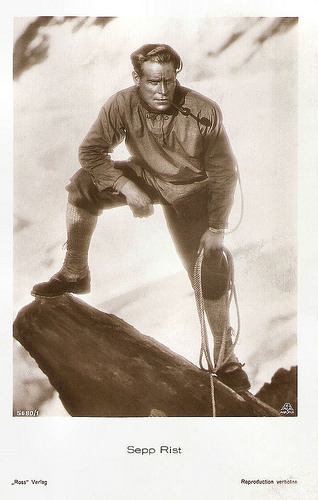
German postcard by Ross Verlag, no. 5680/1, 1930-1931. Photo: Aafa-Film. Publicity still for Stürme über dem Mont Blanc/Storm Over Mont Blanc (Arnold Fanck, 1930).
A violent snow storm
Sepp Rist was born in 1900 in Bad Hindelang in Bavaria. During the First World War, Rist was a stoker on a torpedo boat, and later radio telegrapher on the 1st Submarine Chaser-half-flotilla. From 1920 he worked for the Nuremberg police as a radio operator, and also worked temporarily at the airport in Fürth.
He was also a talented athlete who participated at the 1927 German Ski Championships in Garmisch-Partenkirchen and at other cross-country and jump skiing championships. At a ski race in Gurgl, cameraman Sepp Allgeier spotted him for the film.
Rist’s first film part was the male lead in Arnold Fanck's mountain film Stürme über dem Mont Blanc/Storm Over Mont Blanc (Arnold Fanck, 1930) opposite Leni Riefenstahl . Rist plays meteorologist Hannes who works alone at the Mont Blanc weather station gathering data. His only contact with the world below is via Morse code signals. He is joined by a woman friend, who helps him survive a terrible storm over the mountain.
Filmed on location in Arosa, Switzerland, Babelsberg Observatory in Potsdam, Germany, and Mont-Blanc in Chamonix, France, Wikipedia writes that Stürme über dem Mont Blanc is notable for its dramatic mountain footage and depictions of a violent snow storm. It was shot as a silent film and was later dubbed in the studio.
Stürme über dem Mont Blanc was followed by numerous other films in which Rist always embodied the seasoned Bavarian man image. He reunited with Fanck and Riefenstahl for the German-US drama S.O.S. Eisberg/S.O.S. Iceberg (Arnold Fanck, 1933).
S.O.S. Eisberg was a combination of Mountain film and Disaster film, written by Tom Reed based on a story by Arnold Fanck. An Arctic expedition goes in search of a party that was lost the previous year. S.O.S. Eisberg was filmed on location in Umanak, on the west coast of Greenland, in Iceland, and in the Bernina Alps, on the border between Italy and Switzerland. It was filmed simultaneously in German and English, and released by Universal Studios in both Germany and the United States. Rist appeared in both versions.
He appeared with Brigitte Horney in the Mountain film Der ewige Traum/The Eternal Dream (Arnold Fanck, 1934). In Die Reiter von Deutsch-Ostafrika/The Riders of German East Africa (Herbert Selpin, 1934), he played a German farmer in German East Africa, who is conscripted into the Schutztruppe (German armed colonial force) at the beginning of the First World War.
Rist also had a supporting part as a Gestapo commissioner in the propaganda film Verräter/The Traitor (Karl Ritter, 1936) starring Lída Baarová .
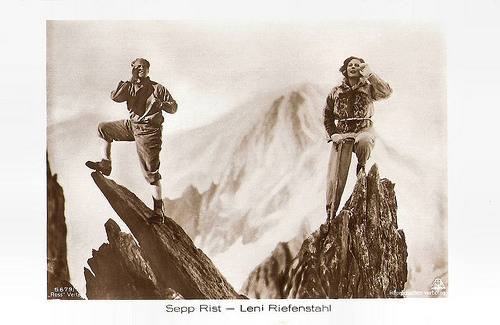
German postcard by Ross Verlag, no. 5679/1, 1930-1931. Photo: Aafa-Film. Publicity still for Stürme über dem Mont Blanc/Storm Over Mont Blanc (Arnold Fanck, 1930) with Leni Riefenstahl .
Filming in far-flung and exotic locations
Quite the adventurer in real life, Sepp Rist was most at home filming in far-flung and exotic locations around the world. In Japan, he appeared in Kokumin no chikai/ The sacred goal (Hiromasa Nomura, 1938).
During the Second World War, Sepp Rist made the Heimat film Die Geierwally/Vulture-Wally (Hans Steinhoff, 1940) with Heidemarie Hatheyer , and Titanic (Werner Klingler, Herbert Selpin, 1943). Titanic used the sinking of the RMS Titanic as a setting for an attempt to discredit British and American capitalist dealings and glorify the bravery and selflessness of German men.
After the war, Sepp Rist frequently appeared in Heimat films, but only in small roles as hunters and foresters. He appeared in the American thriller The Devil Makes Three (Andrew Marton, 1952), set in post-World War II Germany, and starring Gene Kelly and Pier Angeli .
More recently, he played in episodes of such television series as the Krimi Der Kommissar/The Commissioner (1969-1970) with Erik Ode, and Königlich Bayerisches Amtsgericht/Royal Bavarian District Court (1970-1971).
His final films were the Heimat dramas Schloß Hubertus/Hubertus Castle (Harald Reinl, 1973) starring Robert Hoffmann , and Der Jäger von Fall/The Hunter from Fall (Harald Reinl, 1974).
Sepp Rist was married with actress Carla Rust. In 1980, he died at the age of 80 years. His wife had died three years before him.
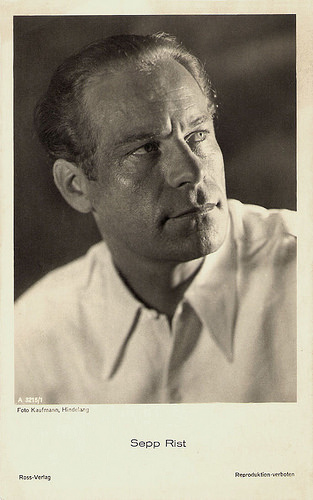
German postcard by Ross Verlag, Berlin, no. A 3215/1, 1941-1944. Photo: Kaufmann, Hindelang.
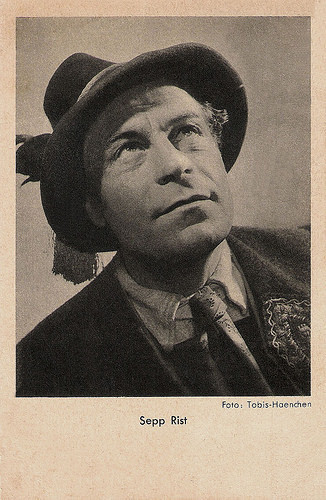
German postcard by Das Programm von Heute für Film und Theater / Ross Verlag, Berlin. Photo: Tobis / Haenchen. Collection: Miss Mertens.
Sources: Stephanie D’heil (Steffi-line - German), Thomas Staedeli (Cyranos – German), Nicole Gagne (AllMovie), Wikipedia (German) and .

German postcard by Ross Verlag, no. 5680/1, 1930-1931. Photo: Aafa-Film. Publicity still for Stürme über dem Mont Blanc/Storm Over Mont Blanc (Arnold Fanck, 1930).
A violent snow storm
Sepp Rist was born in 1900 in Bad Hindelang in Bavaria. During the First World War, Rist was a stoker on a torpedo boat, and later radio telegrapher on the 1st Submarine Chaser-half-flotilla. From 1920 he worked for the Nuremberg police as a radio operator, and also worked temporarily at the airport in Fürth.
He was also a talented athlete who participated at the 1927 German Ski Championships in Garmisch-Partenkirchen and at other cross-country and jump skiing championships. At a ski race in Gurgl, cameraman Sepp Allgeier spotted him for the film.
Rist’s first film part was the male lead in Arnold Fanck's mountain film Stürme über dem Mont Blanc/Storm Over Mont Blanc (Arnold Fanck, 1930) opposite Leni Riefenstahl . Rist plays meteorologist Hannes who works alone at the Mont Blanc weather station gathering data. His only contact with the world below is via Morse code signals. He is joined by a woman friend, who helps him survive a terrible storm over the mountain.
Filmed on location in Arosa, Switzerland, Babelsberg Observatory in Potsdam, Germany, and Mont-Blanc in Chamonix, France, Wikipedia writes that Stürme über dem Mont Blanc is notable for its dramatic mountain footage and depictions of a violent snow storm. It was shot as a silent film and was later dubbed in the studio.
Stürme über dem Mont Blanc was followed by numerous other films in which Rist always embodied the seasoned Bavarian man image. He reunited with Fanck and Riefenstahl for the German-US drama S.O.S. Eisberg/S.O.S. Iceberg (Arnold Fanck, 1933).
S.O.S. Eisberg was a combination of Mountain film and Disaster film, written by Tom Reed based on a story by Arnold Fanck. An Arctic expedition goes in search of a party that was lost the previous year. S.O.S. Eisberg was filmed on location in Umanak, on the west coast of Greenland, in Iceland, and in the Bernina Alps, on the border between Italy and Switzerland. It was filmed simultaneously in German and English, and released by Universal Studios in both Germany and the United States. Rist appeared in both versions.
He appeared with Brigitte Horney in the Mountain film Der ewige Traum/The Eternal Dream (Arnold Fanck, 1934). In Die Reiter von Deutsch-Ostafrika/The Riders of German East Africa (Herbert Selpin, 1934), he played a German farmer in German East Africa, who is conscripted into the Schutztruppe (German armed colonial force) at the beginning of the First World War.
Rist also had a supporting part as a Gestapo commissioner in the propaganda film Verräter/The Traitor (Karl Ritter, 1936) starring Lída Baarová .

German postcard by Ross Verlag, no. 5679/1, 1930-1931. Photo: Aafa-Film. Publicity still for Stürme über dem Mont Blanc/Storm Over Mont Blanc (Arnold Fanck, 1930) with Leni Riefenstahl .
Filming in far-flung and exotic locations
Quite the adventurer in real life, Sepp Rist was most at home filming in far-flung and exotic locations around the world. In Japan, he appeared in Kokumin no chikai/ The sacred goal (Hiromasa Nomura, 1938).
During the Second World War, Sepp Rist made the Heimat film Die Geierwally/Vulture-Wally (Hans Steinhoff, 1940) with Heidemarie Hatheyer , and Titanic (Werner Klingler, Herbert Selpin, 1943). Titanic used the sinking of the RMS Titanic as a setting for an attempt to discredit British and American capitalist dealings and glorify the bravery and selflessness of German men.
After the war, Sepp Rist frequently appeared in Heimat films, but only in small roles as hunters and foresters. He appeared in the American thriller The Devil Makes Three (Andrew Marton, 1952), set in post-World War II Germany, and starring Gene Kelly and Pier Angeli .
More recently, he played in episodes of such television series as the Krimi Der Kommissar/The Commissioner (1969-1970) with Erik Ode, and Königlich Bayerisches Amtsgericht/Royal Bavarian District Court (1970-1971).
His final films were the Heimat dramas Schloß Hubertus/Hubertus Castle (Harald Reinl, 1973) starring Robert Hoffmann , and Der Jäger von Fall/The Hunter from Fall (Harald Reinl, 1974).
Sepp Rist was married with actress Carla Rust. In 1980, he died at the age of 80 years. His wife had died three years before him.

German postcard by Ross Verlag, Berlin, no. A 3215/1, 1941-1944. Photo: Kaufmann, Hindelang.

German postcard by Das Programm von Heute für Film und Theater / Ross Verlag, Berlin. Photo: Tobis / Haenchen. Collection: Miss Mertens.
Sources: Stephanie D’heil (Steffi-line - German), Thomas Staedeli (Cyranos – German), Nicole Gagne (AllMovie), Wikipedia (German) and .
Published on May 04, 2015 22:00
May 3, 2015
Maria Paudler
German actress Maria Paudler (1903-1990) was a popular star of the late silent cinema. She also played the leading role in the first German TV-film.
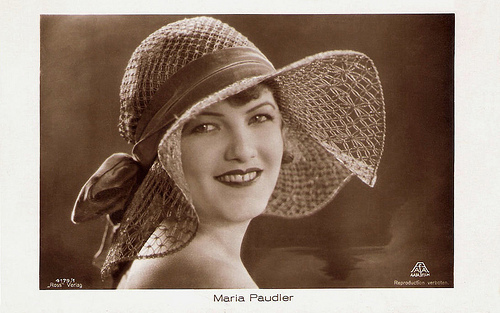
German postcard by Ross Verlag, no. 4179/1, 1929-1930. Photo: Aafa Film.

German postcard by Ross Verlag, no. 91/4. Photo: Aafa Film. Publicity still for Der Bettelstudent/The Beggar Student (Jacob Fleck, Luise Fleck, 1927) with Ernst Verebes .
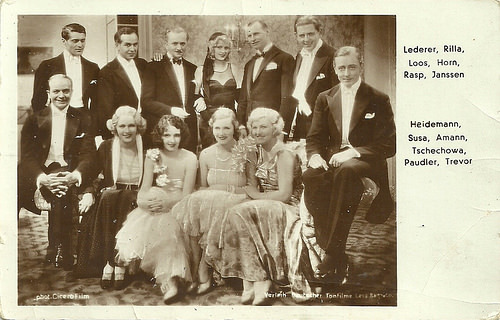
German postcard by Cicero Film. Distribution Deutsche Tonfilme.
The 'fine fleur' of late silent German cinema stars, united for a photo for an early sound film company. Standing left to right: Francis/Franz Lederer , Walter Rilla , Theodor Loos , Camilla Horn , Fritz Rasp and Walter Janssen, Sitting left to right: Paul Heidemann , Charlotte Susa , Betty Amann , Olga Tschechova , Maria Paudler and Jack Trevor . Might be publicity for the early sound comedy Die grosse Sehnsucht/The Great Longing (Stefan Szekely/Steve Sekely, 1930), in which all acted, mostly as themselves - only Loos and Horn played characters. The plot was an excuse for 35 stars to debut in a talking picture.
Harry Liedtke
Maria Paudler was born in Bodenbach, Austria-Hungary (now Podmokly, Czech Republic) in 1903. She was the daughter of an architect.
She studied at the Academy of Music and Performing Arts in Prague, and at the age of 17, she began her theatre career as Gretchen in Faust. In 1923 Leopold Jessner invited her to Berlin to be the partner of Alexander Moissi at the Preußische Staatstheater.
From 1925 on she appeared in her first films like Der Jüngling aus der Konfektion/The Lad From Manufacture (Richard Löwenbein, 1926) with Curt Bois, Madame wünscht keine Kinder/Madame Doesn't Want Children (Alexander Korda, 1926) with Harry Liedtke , Der Veilchenfresser/The Violet Eater (Friedrich Zelnik/Frederic Zelnik, 1926) starring Lil Dagover.
She then starred opposite Harry Liedtke in Der Bettelstudent/The Beggar Student (Jakob Fleck, Luise Fleck, 1927). Other silent films were Die weisse Spinne/The White Spider (Carl Boese, 1927), Orientexpress/Orient Express (Wilhelm Thiele, 1927), and Das letzte Fort/The Last Fort (Kurt Bernhardt/Curtis Bernhardt, 1928).
Maria Paudler was married with the actor Georg Czimag. After the separation she was engaged with her frequent co-star Harry Liedtke .
In the 1930s she concentrated on her stage work in Berlin and Vienna. She only played secondary parts in films like Zwei Welten/Two Worlds (Ewald André Dupont, 1930), Der falsche Ehemann/The Wrong Husband (Johannes Guter, 1931), and Junges Blut/Young Blood (Johannes Guter, 1936).
She also played the leading role in the first German TV film Adrian, der Tulpendieb/Adrian, the Thief of Tulips in 1938.
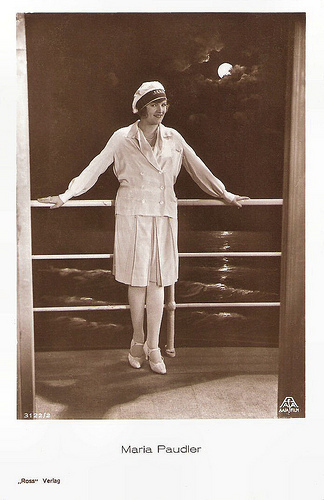
German postcard by Ross-Verlag, no. 3122/2, 1928-1929. Photo: Aafa Film.
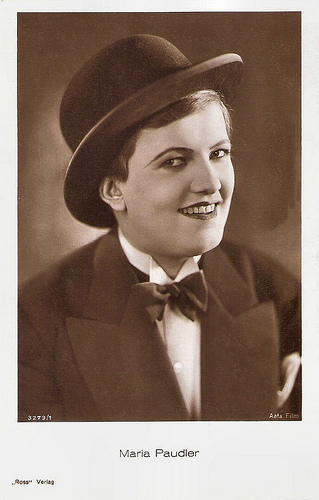
German postcard by Ross Verlag, no. 3273/1, 1928-1929. Photo: Aafa Film.
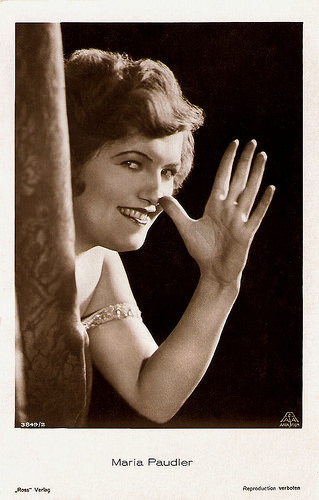
German postcard by Ross Verlag, no. 3849/2, 1928-1929. Photo: Aafa Film.
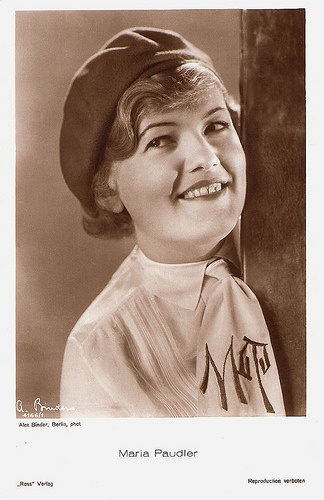
German postcard by Ross Verlag, no. 4166/1, 1929-1930. Photo: Alex Binder.
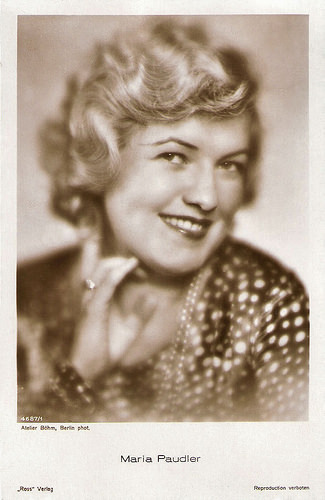
German postcard by Ross Verlag, no. 4687/1, 1929-1930. Photo: Atelier Böhm, Berlin.
Supporting Parts
After the war Maria Paudler was kept prisoner in the Czech Republic, and was only set free after an order of the Red Army. She worked for a few years in Dresden as an actress and a director.
From 1949 till 1951 she had to recover from a serious car accident. She continued her film career in Berlin, and acted in supporting parts in such films as Einmal am Rhein/Once at the Rhine (Helmut Weiss, 1952), the Heinz Rühmann comedy Keine Angst vor grossen Tieren/No Fear For Big Animals (Ulrich Erfurth, 1953), and Ferien auf Immenhof/Holiday at Immenhof (Hermann Leitner, 1957).
In later years she often appeared on TV, like in such crime series as Der Kommissar (1974) and in Polizeiinspektion 1 (1985), which was to be her last role.
In 1968 she was awarded a Bambi, and in 1982 the Filmband in Gold. She published her memoirs in 1977 with the title Auch Lachen will gelernt sein (Laughing Also Has To Be Learned).
Maria Paudler died in 1990 in München. Her second husband was actor and director Kurt Skalden (1895-1975) with whom she had a son, actor Norbert Skalden (1936-1981).
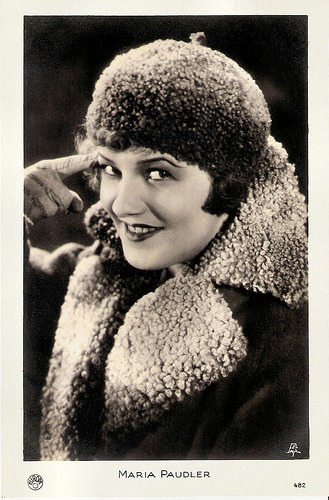
French postcard by Europe, no. 482. Photo: Aafa-Film.
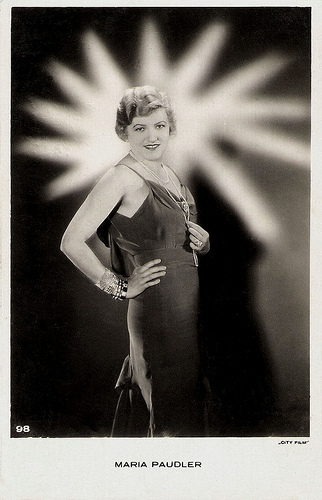
Dutch postcard by City Film, no. 98.
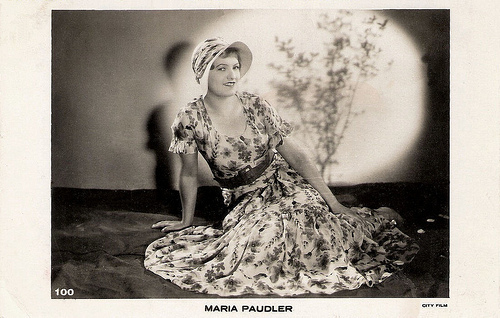
Dutch postcard by City Film, no. 100.
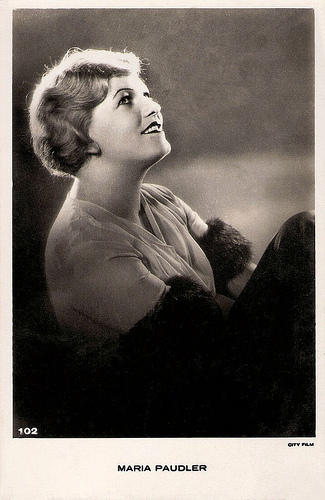
Dutch postcard by City Film, no. 102.
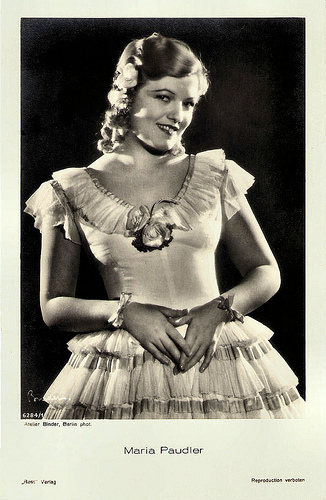
German postcard by Ross Verlag, no. 6284/1, 1931-1932. Sent by mail in the Netherlands. Photo: Alex Binder.
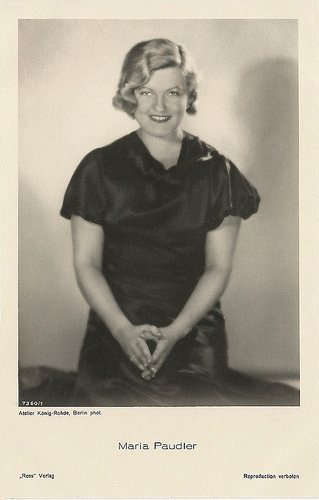
German postcard by Ross Verlag, no. 7360/1, 1932-1933. Collection: Didier Hanson.
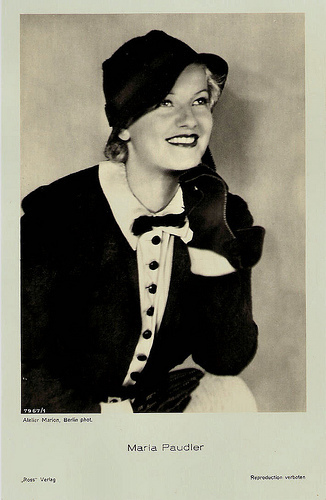
German postcard by Ross Verlag, no. 7967/1, 1932-1933. Photo: Atelier Marion, Berlin.
Sources: Thomas Staedeli (Cyranos), Philippe Pelletier (CinéArtistes - French), Wikipedia (German), and .

German postcard by Ross Verlag, no. 4179/1, 1929-1930. Photo: Aafa Film.

German postcard by Ross Verlag, no. 91/4. Photo: Aafa Film. Publicity still for Der Bettelstudent/The Beggar Student (Jacob Fleck, Luise Fleck, 1927) with Ernst Verebes .

German postcard by Cicero Film. Distribution Deutsche Tonfilme.
The 'fine fleur' of late silent German cinema stars, united for a photo for an early sound film company. Standing left to right: Francis/Franz Lederer , Walter Rilla , Theodor Loos , Camilla Horn , Fritz Rasp and Walter Janssen, Sitting left to right: Paul Heidemann , Charlotte Susa , Betty Amann , Olga Tschechova , Maria Paudler and Jack Trevor . Might be publicity for the early sound comedy Die grosse Sehnsucht/The Great Longing (Stefan Szekely/Steve Sekely, 1930), in which all acted, mostly as themselves - only Loos and Horn played characters. The plot was an excuse for 35 stars to debut in a talking picture.
Harry Liedtke
Maria Paudler was born in Bodenbach, Austria-Hungary (now Podmokly, Czech Republic) in 1903. She was the daughter of an architect.
She studied at the Academy of Music and Performing Arts in Prague, and at the age of 17, she began her theatre career as Gretchen in Faust. In 1923 Leopold Jessner invited her to Berlin to be the partner of Alexander Moissi at the Preußische Staatstheater.
From 1925 on she appeared in her first films like Der Jüngling aus der Konfektion/The Lad From Manufacture (Richard Löwenbein, 1926) with Curt Bois, Madame wünscht keine Kinder/Madame Doesn't Want Children (Alexander Korda, 1926) with Harry Liedtke , Der Veilchenfresser/The Violet Eater (Friedrich Zelnik/Frederic Zelnik, 1926) starring Lil Dagover.
She then starred opposite Harry Liedtke in Der Bettelstudent/The Beggar Student (Jakob Fleck, Luise Fleck, 1927). Other silent films were Die weisse Spinne/The White Spider (Carl Boese, 1927), Orientexpress/Orient Express (Wilhelm Thiele, 1927), and Das letzte Fort/The Last Fort (Kurt Bernhardt/Curtis Bernhardt, 1928).
Maria Paudler was married with the actor Georg Czimag. After the separation she was engaged with her frequent co-star Harry Liedtke .
In the 1930s she concentrated on her stage work in Berlin and Vienna. She only played secondary parts in films like Zwei Welten/Two Worlds (Ewald André Dupont, 1930), Der falsche Ehemann/The Wrong Husband (Johannes Guter, 1931), and Junges Blut/Young Blood (Johannes Guter, 1936).
She also played the leading role in the first German TV film Adrian, der Tulpendieb/Adrian, the Thief of Tulips in 1938.

German postcard by Ross-Verlag, no. 3122/2, 1928-1929. Photo: Aafa Film.

German postcard by Ross Verlag, no. 3273/1, 1928-1929. Photo: Aafa Film.

German postcard by Ross Verlag, no. 3849/2, 1928-1929. Photo: Aafa Film.

German postcard by Ross Verlag, no. 4166/1, 1929-1930. Photo: Alex Binder.

German postcard by Ross Verlag, no. 4687/1, 1929-1930. Photo: Atelier Böhm, Berlin.
Supporting Parts
After the war Maria Paudler was kept prisoner in the Czech Republic, and was only set free after an order of the Red Army. She worked for a few years in Dresden as an actress and a director.
From 1949 till 1951 she had to recover from a serious car accident. She continued her film career in Berlin, and acted in supporting parts in such films as Einmal am Rhein/Once at the Rhine (Helmut Weiss, 1952), the Heinz Rühmann comedy Keine Angst vor grossen Tieren/No Fear For Big Animals (Ulrich Erfurth, 1953), and Ferien auf Immenhof/Holiday at Immenhof (Hermann Leitner, 1957).
In later years she often appeared on TV, like in such crime series as Der Kommissar (1974) and in Polizeiinspektion 1 (1985), which was to be her last role.
In 1968 she was awarded a Bambi, and in 1982 the Filmband in Gold. She published her memoirs in 1977 with the title Auch Lachen will gelernt sein (Laughing Also Has To Be Learned).
Maria Paudler died in 1990 in München. Her second husband was actor and director Kurt Skalden (1895-1975) with whom she had a son, actor Norbert Skalden (1936-1981).

French postcard by Europe, no. 482. Photo: Aafa-Film.

Dutch postcard by City Film, no. 98.

Dutch postcard by City Film, no. 100.

Dutch postcard by City Film, no. 102.

German postcard by Ross Verlag, no. 6284/1, 1931-1932. Sent by mail in the Netherlands. Photo: Alex Binder.

German postcard by Ross Verlag, no. 7360/1, 1932-1933. Collection: Didier Hanson.

German postcard by Ross Verlag, no. 7967/1, 1932-1933. Photo: Atelier Marion, Berlin.
Sources: Thomas Staedeli (Cyranos), Philippe Pelletier (CinéArtistes - French), Wikipedia (German), and .
Published on May 03, 2015 22:00
May 2, 2015
Patachou
On 30 April. French singer and actress Patachou (1918-2015) passed away. She was a mythical icon of the French chanson. With her full voice and typical Parisian accent, Patachou was very popular in France during the 1950s, and also had a successful international career. She discovered singer Georges Brassens and song writer Guy Béart. She also appeared on stage and in several French films, including a memorable turn as the charming grand-mother Mathilde in the art-house hit Drôle de Félix/Funny Felix (2000).
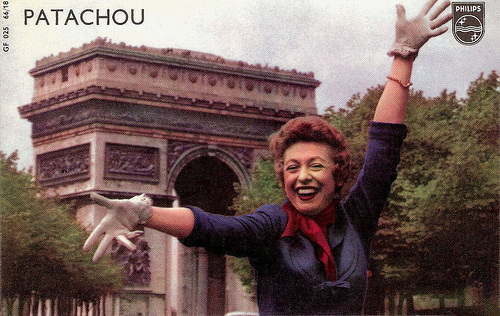
Vintage postcard, no. GF 025 66/18. Photo: Philips.
Puff Dough
Patachou was born as Henriette Eugénie Jeanne Ragon in Paris, in the poor, working-class district of Ménilmontant, in 1918. Her father was a ceramist, her mother a housewife. Henriette grew up as an only child in a family where the household income was modest, but parents and child were remarkably close.
She began her working life as a typist, then worked as a factory worker, a shoeseller, and as an antique dealer. In 1948, with her husband Jean Billou, she took over a cabaret-restaurant on the butte of Montmartre, called Patachou. Henriette became a popular fixture behind the bar.
She became famous for snipping off the ends of customers' ties! and also performed in her patisserie-bistro at the request of the guests. One of those guests was the famous entertainer Maurice Chevalier , who encouraged her to become a professional singer. French journalists began to call her Lady Patachou after the name of her cabaret restaurant (pâte-à-choux means cream puff dough).
She sang pre-war songs like Mon homme and Domino. Many chanson singers like Édith Piaf , Jacques Brel and Charles Aznavour also performed in her cabaret-restaurant. From 1952 her first records appeared; she appeared at Bobino, a Montparnasse music-hall, toured in France and then further afield.
In 1952, the then unknown Georges Brassens sang there, and together Patachou and he sang the duet Maman, papa. Patachou was the first interpreter of his songs like Le bricoleur and La chasse aux papillons, and she introduced them to a broad audience. Later she would be the first to perform songs by Guy Béart, the father of film star Emmanuelle Béart .
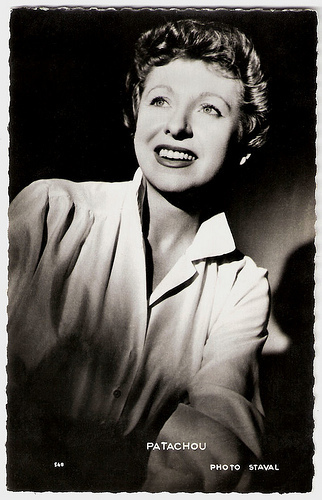
French postcard by Editions P.I., no. 540. Photo: Staval.
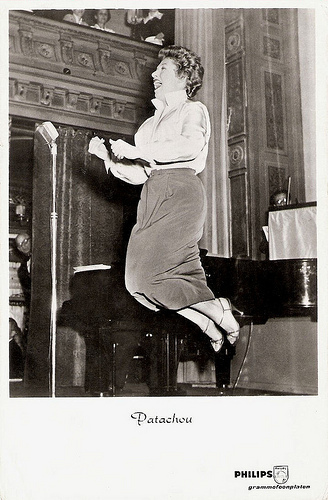
Dutch postcard by Gebr. Spanjersberg N.V., Rotterdam, for Philips Grammofoonplaten, no. 5132. Photo: Editions ALTONA, Amsterdam.
Sunshine Girl
Patachou also became popular as a film star in the early 1950s. She appeared in the films Femmes de Paris/Women of Paris (Jean Boyer, 1953), French Cancan (Jean Renoir, 1954) with Jean Gabin , and Napoléon (Sacha Guitry, 1954).
From 1953, she toured through the United States and performed at the Palladium, the Waldorf Astoria, and Carnegie Hall. She stayed for more than 20 years in the US, and performed more than 20 times in the legendary Ed Sullivan Show on TV. The Americans gave her the nickname ‘Sunshine girl’.
Following her divorce, Patachou married the American-born impresario Arthur Lesser and began planning a series of new musicals which she hoped would assure her a major comeback in France. But France was firmly in the grip of the Yé-yé craze and there appeared to be little place for artists of the 'older generation.' Patachou found that out to her cost when she returned to France in the late 1960s.
She soldiered on with her career, nevertheless, performing at small, low-key cabarets and at the restaurant on top of the Eiffel Tower. From the beginning of the 1970s, Patachou toured Japan and Sweden where L'eternal Parigot, with her cheeky Parisian register was still popular.
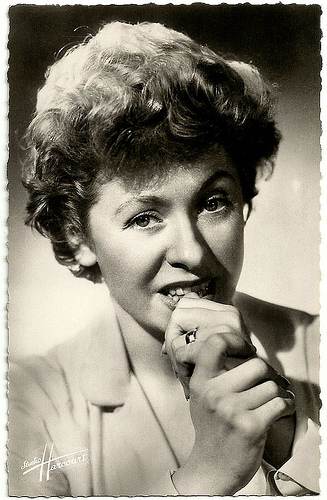
French postcard by Editions du Globe, no. 264. Photo: Studio Harcourt.
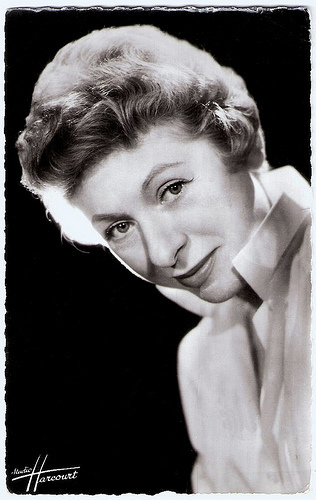
French postcard by Editions du Globe, Paris. Photo: Studio Harcourt, Paris.
Charming Grand-mother
Patachou finished her singing career, but in the 1980s she became again a well known actress on television and in the cinema. In 1983, Patachou made her screen come-back, appearing in the television film, Disparu le 7 octobre/Disappeared on 7 October (Jacques Ertaud, 1983).
Rfi music : "This opened a whole new chapter in her career and the French public witnessed their 'chanson' idol blossom into a fully-fledged actress as Patachou enjoyed a new lease of life, playing glamorous grandmothers.
In 1985, Patachou made her début in the French theatre, playing a lead role in Edouard Bourdet's play Le Sexe faible, staged at the Théâtre Hébertot.
Among her later films were Faubourg St Martin (Jean-Claude Guiguet, 1986) with Françoise Fabian, La Rumba (Roger Hanin, 1987) with Michel Piccoli , Pola X (Leos Carax, 1999) with Catherine Deneuve , and Les Acteurs/Actors (Bertrand Blier, 2000).
Probably her best known film role was the charming grand-mother Mathilde in the art-house hit Drôle de Félix/Funny Felix (Olivier Ducastel, Jacques Martineau, 2000) starring Sami Bouajila. Her most recent film was San-Antonio (Frédéric Auburtin, 2003) starring Gérard Depardieu .
Patachou was named Commandeur des Arts et des Lettres in 2004. With Jean Billou she has a son, Pierre Billou, who had a certain success as a singer in the 1970s and wrote J'ai oublié de vivre for Johnny Hallyday . Patachou died of natural causes in Neuilly-sur-Seine near Paris. She was 96.
Patachou sings Chanson d'Irma La Douce. Source: Kaatjeaster (YouTube).
Trailer of Drôle de Félix/Funny Felix (2000). Source: peccadillopictures (YouTube).
Sources: Rfi music, Sylvester Hoogmoed (Het Chanson), Les gens du Cinema (French), Wikipedia and .

Vintage postcard, no. GF 025 66/18. Photo: Philips.
Puff Dough
Patachou was born as Henriette Eugénie Jeanne Ragon in Paris, in the poor, working-class district of Ménilmontant, in 1918. Her father was a ceramist, her mother a housewife. Henriette grew up as an only child in a family where the household income was modest, but parents and child were remarkably close.
She began her working life as a typist, then worked as a factory worker, a shoeseller, and as an antique dealer. In 1948, with her husband Jean Billou, she took over a cabaret-restaurant on the butte of Montmartre, called Patachou. Henriette became a popular fixture behind the bar.
She became famous for snipping off the ends of customers' ties! and also performed in her patisserie-bistro at the request of the guests. One of those guests was the famous entertainer Maurice Chevalier , who encouraged her to become a professional singer. French journalists began to call her Lady Patachou after the name of her cabaret restaurant (pâte-à-choux means cream puff dough).
She sang pre-war songs like Mon homme and Domino. Many chanson singers like Édith Piaf , Jacques Brel and Charles Aznavour also performed in her cabaret-restaurant. From 1952 her first records appeared; she appeared at Bobino, a Montparnasse music-hall, toured in France and then further afield.
In 1952, the then unknown Georges Brassens sang there, and together Patachou and he sang the duet Maman, papa. Patachou was the first interpreter of his songs like Le bricoleur and La chasse aux papillons, and she introduced them to a broad audience. Later she would be the first to perform songs by Guy Béart, the father of film star Emmanuelle Béart .

French postcard by Editions P.I., no. 540. Photo: Staval.

Dutch postcard by Gebr. Spanjersberg N.V., Rotterdam, for Philips Grammofoonplaten, no. 5132. Photo: Editions ALTONA, Amsterdam.
Sunshine Girl
Patachou also became popular as a film star in the early 1950s. She appeared in the films Femmes de Paris/Women of Paris (Jean Boyer, 1953), French Cancan (Jean Renoir, 1954) with Jean Gabin , and Napoléon (Sacha Guitry, 1954).
From 1953, she toured through the United States and performed at the Palladium, the Waldorf Astoria, and Carnegie Hall. She stayed for more than 20 years in the US, and performed more than 20 times in the legendary Ed Sullivan Show on TV. The Americans gave her the nickname ‘Sunshine girl’.
Following her divorce, Patachou married the American-born impresario Arthur Lesser and began planning a series of new musicals which she hoped would assure her a major comeback in France. But France was firmly in the grip of the Yé-yé craze and there appeared to be little place for artists of the 'older generation.' Patachou found that out to her cost when she returned to France in the late 1960s.
She soldiered on with her career, nevertheless, performing at small, low-key cabarets and at the restaurant on top of the Eiffel Tower. From the beginning of the 1970s, Patachou toured Japan and Sweden where L'eternal Parigot, with her cheeky Parisian register was still popular.

French postcard by Editions du Globe, no. 264. Photo: Studio Harcourt.

French postcard by Editions du Globe, Paris. Photo: Studio Harcourt, Paris.
Charming Grand-mother
Patachou finished her singing career, but in the 1980s she became again a well known actress on television and in the cinema. In 1983, Patachou made her screen come-back, appearing in the television film, Disparu le 7 octobre/Disappeared on 7 October (Jacques Ertaud, 1983).
Rfi music : "This opened a whole new chapter in her career and the French public witnessed their 'chanson' idol blossom into a fully-fledged actress as Patachou enjoyed a new lease of life, playing glamorous grandmothers.
In 1985, Patachou made her début in the French theatre, playing a lead role in Edouard Bourdet's play Le Sexe faible, staged at the Théâtre Hébertot.
Among her later films were Faubourg St Martin (Jean-Claude Guiguet, 1986) with Françoise Fabian, La Rumba (Roger Hanin, 1987) with Michel Piccoli , Pola X (Leos Carax, 1999) with Catherine Deneuve , and Les Acteurs/Actors (Bertrand Blier, 2000).
Probably her best known film role was the charming grand-mother Mathilde in the art-house hit Drôle de Félix/Funny Felix (Olivier Ducastel, Jacques Martineau, 2000) starring Sami Bouajila. Her most recent film was San-Antonio (Frédéric Auburtin, 2003) starring Gérard Depardieu .
Patachou was named Commandeur des Arts et des Lettres in 2004. With Jean Billou she has a son, Pierre Billou, who had a certain success as a singer in the 1970s and wrote J'ai oublié de vivre for Johnny Hallyday . Patachou died of natural causes in Neuilly-sur-Seine near Paris. She was 96.
Patachou sings Chanson d'Irma La Douce. Source: Kaatjeaster (YouTube).
Trailer of Drôle de Félix/Funny Felix (2000). Source: peccadillopictures (YouTube).
Sources: Rfi music, Sylvester Hoogmoed (Het Chanson), Les gens du Cinema (French), Wikipedia and .
Published on May 02, 2015 22:00
May 1, 2015
L'arzigogolo (1924)
Today's film special is about the Italian silent film L'arzigogolo/The Court Jester (Mario Almirante, 1924). The successful costume drama starred diva Italia Almirante Manzini, Annibale Betrone and Oreste Bilancia.
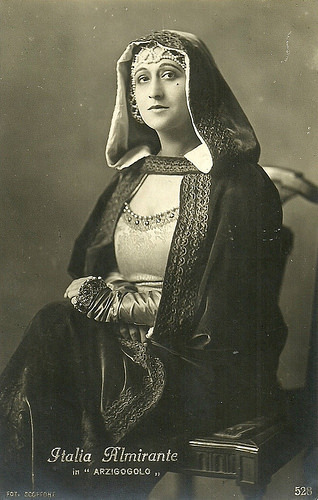
Italian postcard by Ballerini & Fratini, Firenze, no. 528. Photo: Scoffone. Publicity still for L'arzigogolo (Mario Almirante, 1924), with Italia Almirante Manzini .
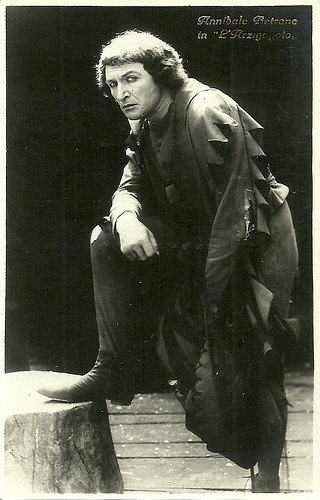
Italian postcard by Ed. G.B. Falci, Milano. Photo: publicity still for L'arzigogolo (Mario Almirante, 1924) with Annibale Betrone.
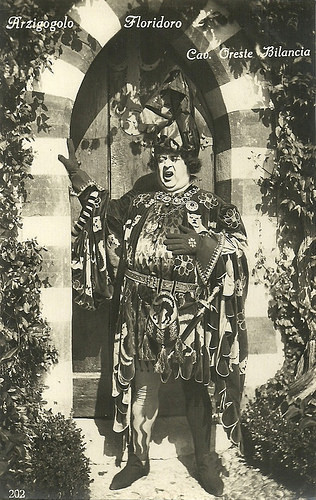
Italian postcard by Ballerini & Fratini, Firenze, no. 202. Photo: Alba Film. Publicity still for L'arzigogolo (Mario Almirante, 1924) with Oreste Bilancia .
An Attractive Cast
The costume drama L'arzigogolo (Mario Almirante, 1924) has an attractive cast.
Leading lady is Italia Almirante Manzini (1890-1941), wife of director Mario Almirante. Italia had starred in the classic epic Cabiria (1914) and was one of the divas of the Italian silent cinema.
The court jester of the title was played by Annibale Betrone (1883-1950). He was an important figure of the Italian theatre of the first half of the 20th century. Betrone also appeared in several silent and sound films.
Oreste Bilancia (1881-1945) was another well known face of the Italian silent cinema. As in L'arzigogolo, he mostly worked as supporting actor, but occasionally he played the main character.
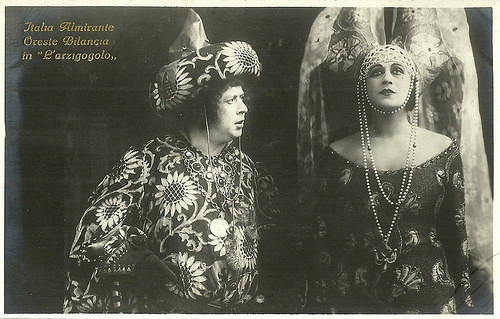
Italian postcard by Ed. G.B. Falci, Milano, no. 197. Photo: publicity still for L'arzigogolo (Mario Almirante, 1924) with Oreste Bilancia and Italia Almirante Manzini .
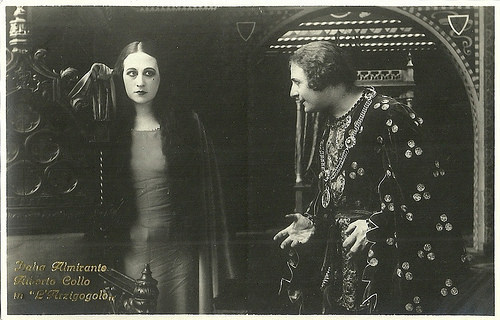
Italian postcard by G.B. Falci, Milano, no. 209. Photo: publicity still for L'arzigogolo (Mario Almirante, 1924) with Italia Almirante Manzini and Annibale Betrone.
Classic Love Story
L'arzigogolo is a classic love story in the vain of William Shakespeare's Romeo and Juliet. The story was a liberal adaptation of a popular 1922 stage play by Sem Benelli. The sets were designed by Luigi Sapelli, better known as Caramba, who specialized in costume dramas. Director of photography was Ubaldo Arata, who was one of Italy's most famous cinematographers.
Italia Almirante plays Monna Violante, daughter of the Prince of Capri, who is wed by her father to the rich merchant Floridoro ( Oreste Bilancia ), a fat and wealthy merchant, confident and convinced of being protected by good fortune.
Monna Violante falls in love with Spallatonda (Annibale Betrone), the court jester and servant of count Giano ( Alberto Collo ), one of her suitors. After Giano has been killed by the hand of Spallatonda, Monna Violante and Spallatonda run away.
After the premiere, the critic of Il Roma della Domenica wrote: "L'arzigogolo did not delude the high expectations, because it is the result on screen of an original and interesting work. Therefore the poet (Sem Benelli) can be satisfied."
The critic of La Vita Cinematografica adds: "We never saw Italia Almirante so perfect in place. She exquisitely figures as an intelligent woman. Her plastic beauty, preserved by exuberant costumes, makes the complex and enigmatic character of Violante more fascinating and suggestive."
L'arzigogolo became one of the most successful films in Italy of 1924.
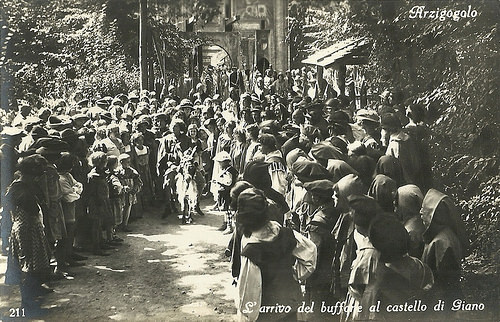
Italian postcard by Ballerini & Fratini, Firenze, no. 211. Photo: Alba Film. Publicity still for L'arzigogolo (Mario Almirante, 1924). Caption: The arrival of the buffoon at the castle of Giano.
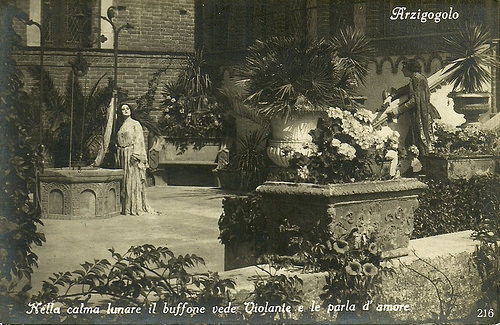
Italian postcard by Ballerini & Fratini, Firenze, no. 216. Photo: Alba Film. Publicity still for L'arzigogolo (Mario Almirante, 1924), with Italia Almirante Manzini and Annibale Betrone. Caption: In the calm moonlight the buffoon sees Violante and declares her his love.
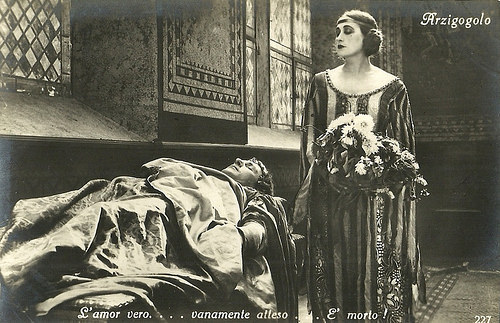
Italian postcard by Ballerini & Fratini, Firenze, no. 227. Photo: Alba Film. Publicity still for L'arzigogolo (Mario Almirante, 1924), with Annibale Betrone and Italia Almirante Manzini . Caption: True love...attained in vain... He is dead!
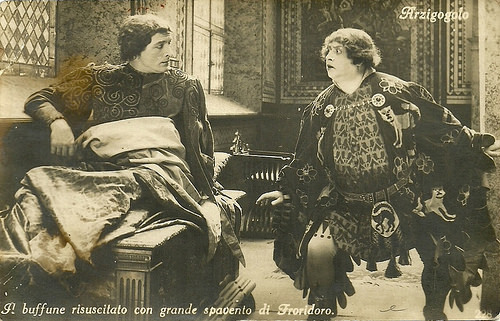
Italian postcard by Ballerini & Fratini, Firenze, no. 228. Photo: Alba Film. Publicity still for L'arzigogolo (Mario Almirante, 1924), with Annibale Betrone and Oreste Bilancia . Caption: The buffoon resurrected to the great terror of Floridoro.
Sources: Vittorio Martinelli (Il Cinema Muto Italiano 1923-1931 - Italian), Wikipedia (Italian) and IMDb.

Italian postcard by Ballerini & Fratini, Firenze, no. 528. Photo: Scoffone. Publicity still for L'arzigogolo (Mario Almirante, 1924), with Italia Almirante Manzini .

Italian postcard by Ed. G.B. Falci, Milano. Photo: publicity still for L'arzigogolo (Mario Almirante, 1924) with Annibale Betrone.

Italian postcard by Ballerini & Fratini, Firenze, no. 202. Photo: Alba Film. Publicity still for L'arzigogolo (Mario Almirante, 1924) with Oreste Bilancia .
An Attractive Cast
The costume drama L'arzigogolo (Mario Almirante, 1924) has an attractive cast.
Leading lady is Italia Almirante Manzini (1890-1941), wife of director Mario Almirante. Italia had starred in the classic epic Cabiria (1914) and was one of the divas of the Italian silent cinema.
The court jester of the title was played by Annibale Betrone (1883-1950). He was an important figure of the Italian theatre of the first half of the 20th century. Betrone also appeared in several silent and sound films.
Oreste Bilancia (1881-1945) was another well known face of the Italian silent cinema. As in L'arzigogolo, he mostly worked as supporting actor, but occasionally he played the main character.

Italian postcard by Ed. G.B. Falci, Milano, no. 197. Photo: publicity still for L'arzigogolo (Mario Almirante, 1924) with Oreste Bilancia and Italia Almirante Manzini .

Italian postcard by G.B. Falci, Milano, no. 209. Photo: publicity still for L'arzigogolo (Mario Almirante, 1924) with Italia Almirante Manzini and Annibale Betrone.
Classic Love Story
L'arzigogolo is a classic love story in the vain of William Shakespeare's Romeo and Juliet. The story was a liberal adaptation of a popular 1922 stage play by Sem Benelli. The sets were designed by Luigi Sapelli, better known as Caramba, who specialized in costume dramas. Director of photography was Ubaldo Arata, who was one of Italy's most famous cinematographers.
Italia Almirante plays Monna Violante, daughter of the Prince of Capri, who is wed by her father to the rich merchant Floridoro ( Oreste Bilancia ), a fat and wealthy merchant, confident and convinced of being protected by good fortune.
Monna Violante falls in love with Spallatonda (Annibale Betrone), the court jester and servant of count Giano ( Alberto Collo ), one of her suitors. After Giano has been killed by the hand of Spallatonda, Monna Violante and Spallatonda run away.
After the premiere, the critic of Il Roma della Domenica wrote: "L'arzigogolo did not delude the high expectations, because it is the result on screen of an original and interesting work. Therefore the poet (Sem Benelli) can be satisfied."
The critic of La Vita Cinematografica adds: "We never saw Italia Almirante so perfect in place. She exquisitely figures as an intelligent woman. Her plastic beauty, preserved by exuberant costumes, makes the complex and enigmatic character of Violante more fascinating and suggestive."
L'arzigogolo became one of the most successful films in Italy of 1924.

Italian postcard by Ballerini & Fratini, Firenze, no. 211. Photo: Alba Film. Publicity still for L'arzigogolo (Mario Almirante, 1924). Caption: The arrival of the buffoon at the castle of Giano.

Italian postcard by Ballerini & Fratini, Firenze, no. 216. Photo: Alba Film. Publicity still for L'arzigogolo (Mario Almirante, 1924), with Italia Almirante Manzini and Annibale Betrone. Caption: In the calm moonlight the buffoon sees Violante and declares her his love.

Italian postcard by Ballerini & Fratini, Firenze, no. 227. Photo: Alba Film. Publicity still for L'arzigogolo (Mario Almirante, 1924), with Annibale Betrone and Italia Almirante Manzini . Caption: True love...attained in vain... He is dead!

Italian postcard by Ballerini & Fratini, Firenze, no. 228. Photo: Alba Film. Publicity still for L'arzigogolo (Mario Almirante, 1924), with Annibale Betrone and Oreste Bilancia . Caption: The buffoon resurrected to the great terror of Floridoro.
Sources: Vittorio Martinelli (Il Cinema Muto Italiano 1923-1931 - Italian), Wikipedia (Italian) and IMDb.
Published on May 01, 2015 22:00
April 30, 2015
Käthe von Nagy
Hungarian actress Käthe von Nagy (1904-1973) started as the ‘Backfish’ of German films of the late 1920s. In the early 1930s she became a fashionable and charming star of the German and French cinema.
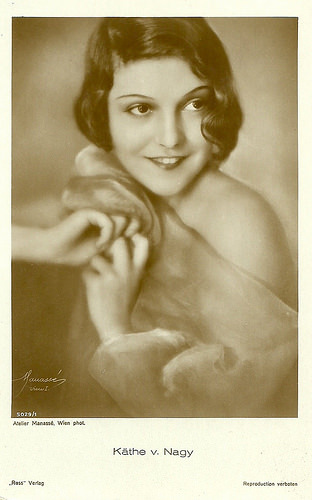
German postcard by Ross Verlag, no. 5029/1, 1930-1931. Photo: Atelier Manassé, Vienna.
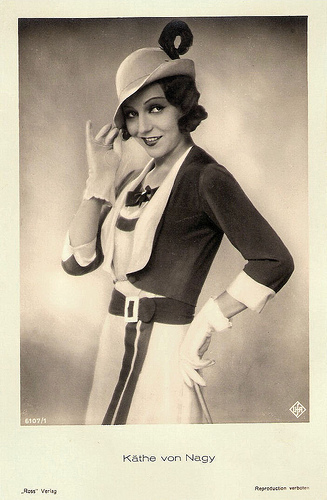
German postcard by Ross Verlag, no. 6107/1, 1931-1932. Photo: Ufa.
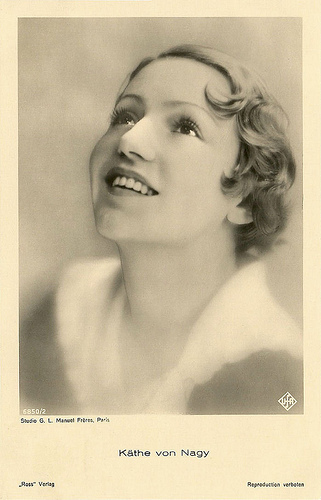
German postcard by Ross Verlag, no. 6850/2, 1931-1932. Photo: G.L. Manuel Frères, Paris / Ufa. Collection: Didier Hanson.
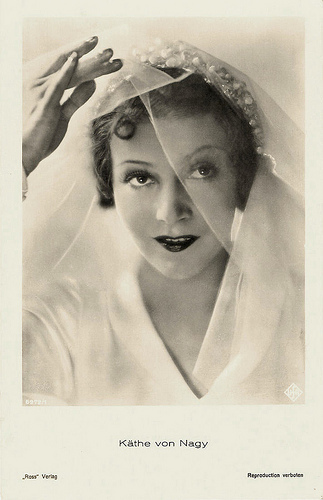
German postcard by Ross Verlag, no. 6972/1, 1931-1932. Photo: Ufa. Publicity still for Das schöne Abenteuer/Beautiful Adventure (Reinhold Schünzel, 1932).
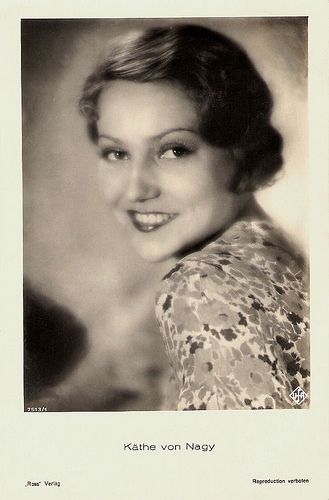
German postcard by Ross Verlag, no. 7513/1, 1932-1933. Photo: Ufa.
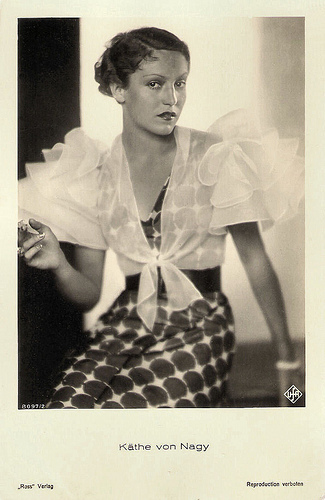
German postcard by Ross Verlag, no. 8097/2, 1933-1934. Photo: Ufa.
Backfisch
Käthe von Nagy was born Ekaterina Nagy von Cziser (Kato Nagy) in Szabadka, Austria-Hungary (now: Subotica, Serbia) in 1904.
At the age of 16 she planned to get married and therefore her parents put her in the Sancta Christiana Convent near Vienna. After that, she worked in her father's bank office in Budapest and secretly started to write short stories for a newspaper. She also attended the acting school of director Béla Gáal and in 1926, against the will of her parents, she went to Berlin to make films.
While searching for an acting job she earned her money as a correspondent for the Hungarian newspaper Pester Hirlop. Hungarian director Alexander Korda helped her get her first film job. It was a supporting role in Männer von der Ehe/Men Before Marriage (Constantin J. David, 1927), which got her the reputation of a ‘backfisch’. The director, Constantin David, would also become her first husband.
Soon followed roles in Gustav Mond... Du gehst so stille/You Walk So Softly (Reinhold Schünzel, 1927) and Die Königin seines Herzens/Vienna, City of My Dreams (Victor Janson, 1928) starring Liane Haid .
With her first leading role in Die Durchgängerin/The Runaway Girl (Hanns Schwarz, 1928) she became the up-and-coming young actress of the European cinema of the 1920s. N
ext followed the Italian production Rotaie (Mario Camerini, 1929) and Mascottchen/Mascots (Felix Basch, 1929) with Jeanne Helbling .
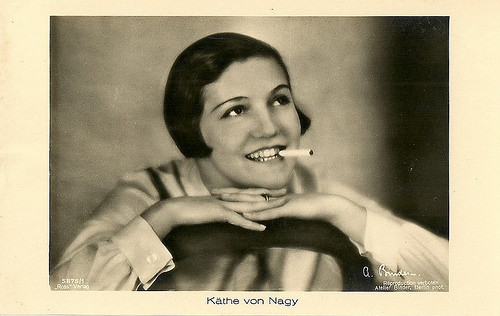
German postcard by Ross Verlag, no. 5875/1, 1930-1931. Photo: Alex Binder.
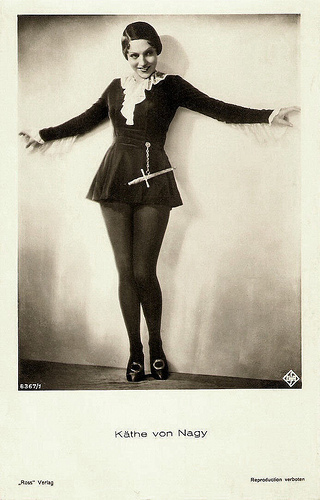
German postcard by Ross Verlag, no. 6367/1, 1931-1932. Photo: Ufa.
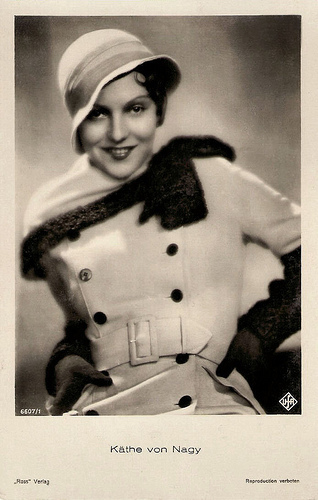
German postcard by Ross Verlag, no. 6807/1, 1931-1932. Photo: Ufa.
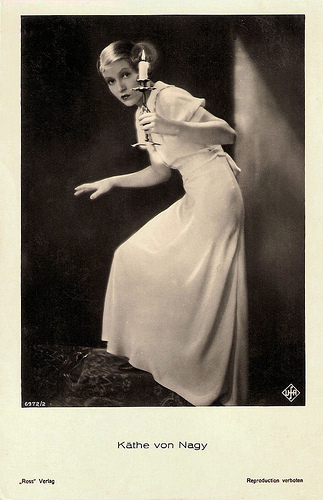
German postcard by Ross Verlag, no. 6972/2, 1931-1932. Photo: Ufa.
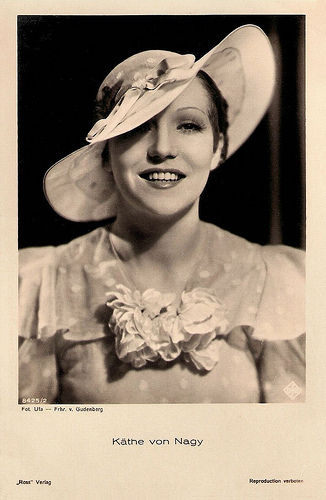
German postcard by Ross Verlag, no. 6415/2, 1931-1932. Photo: Ufa / Frhr. v. Gudenburg.
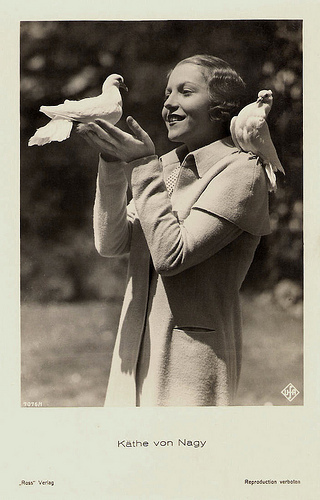
German postcard by Ross Verlag, no. 7076/1, 1932-1933. Photo: Ufa.
The fashionable, elegant, a bit exotic type
In 1930, Käthe von Nagy smoothly moved into the talkies. She appeared as a resolute demimonde dame with psychotherapeutic powers in the Jekyll-and-Hyde-drama Der Andere/The Other (Robert Wiene, 1930), costarring Fritz Kortner and Heinrich George .
She said goodbye to her ‘backfisch’ image and impersonated frequently on the screen. Her operettas and musical comedies were very popular and confirmed her promise of the late 1920s.
To her successes of the 1930s belong Ihre Majestät die Liebe/Her Majesty Love (Joe May, 1930) with Franz Lederer , Meine Frau, die Hochstaplerin/My Wife, the Impostor (Kurt Gerron, 1931) opposite Heinz Rühmann , Ronny (Reinhold Schünzel, 1931), Ich bei Tag und Du bei Nacht/I by Day, You by Night (Ludwig Berger, 1932) opposite Willy Fritsch , Der Sieger/The Victor (Hans Hinrich, Paul Martin, 1932) with Hans Albers , Das Schöne Abenteuer/Beautiful Adventure (Reinhold Schünzel, 1932), the anti-Soviet propaganda film Flüchtlinge/Fugitives (Gustav Ucicky, 1933), Die Töchter ihrer Exzellenz/The daughters of Her Excellency (Reinhold Schünzel, 1934) and Salonwagen E 417/Luxury Train (Paul Verhoeven, 1939) with Paul Hörbiger .
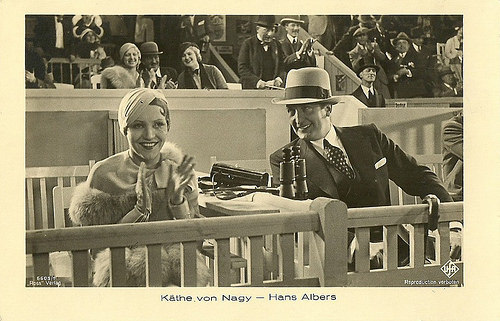
German postcard by Ross Verlag, no. 6605/1, 1931-1932. Photo: Ufa. Publicity still for Der Sieger/The Winner (Paul Martin, Hans Hinrich, 1932) with Hans Albers .
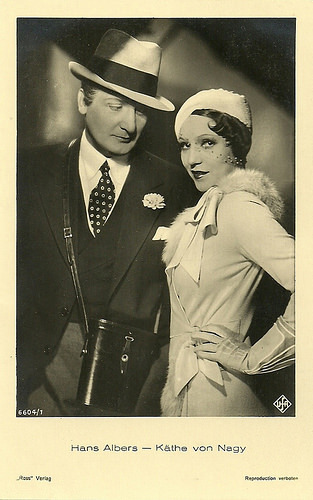
German postcard by Ross Verlag, no. 6604/1, 1931-1932. Photo: Ufa. Publicity still for Der Sieger/The Winner (Paul Martin, Hans Hinrich, 1932) with Hans Albers .
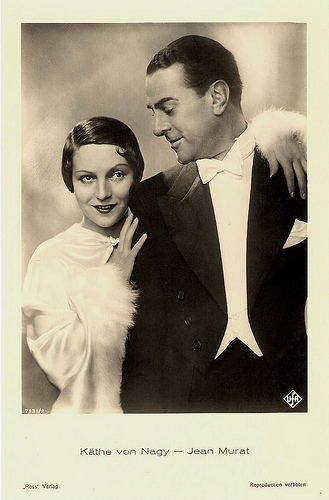
German postcard by Ross Verlag, no. 7131/2, 1932-1933. Photo: Ufa. Publicity still for Le capitaine Craddock/Captain Craddock (Hanns Schwarz, Max de Vaucorbeil, 1931) with Jean Murat .
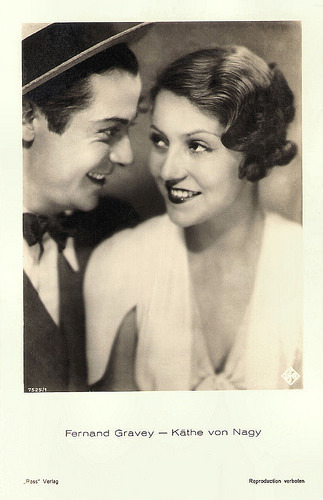
German postcard by Ross Verlag, no. 7535/1, 1932-1933. Photo: Ufa. Publicity still for À Moi le Jour, à Toi la Nuit/Day To Me, to You the Night (Ludwig Berger, Claude Heymann, 1932) with Fernand Gravey .
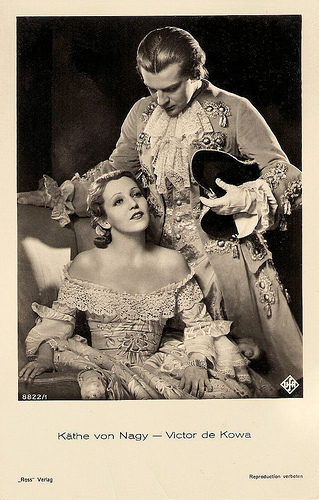
German postcard by Ross Verlag, no. 8822/1, 1933-1934. Photo: Ufa. Publicity still for Der junge Baron Neuhaus/The Young Baron Neuhaus (Gustav Ucicky, 1934) with Viktor de Kowa .
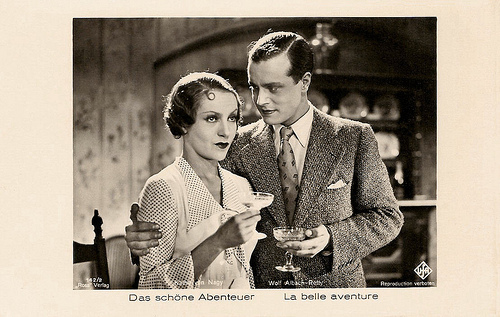
German postcard by Ross Verlag, no. 142/2. Photo: Günther Pilz / Ufa. Publicity still for Das Schöne Abenteuer/Beautiful Adventure (Reinhold Schünzel, 1932) with Wolf Albach-Retty .
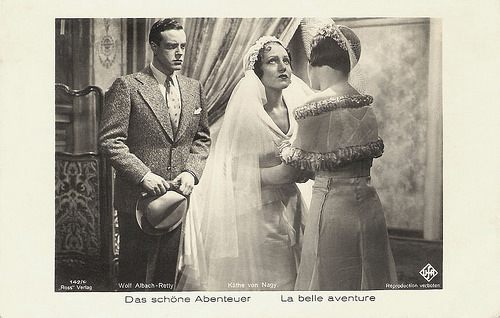
German postcard by Ross Verlag, no. 142/6. Photo: Ufa. Publicity still for Das schöne Abenteuer/Beautiful Adventure (Reinhold Schünzel, 1932) with Wolf Albach-Retty .
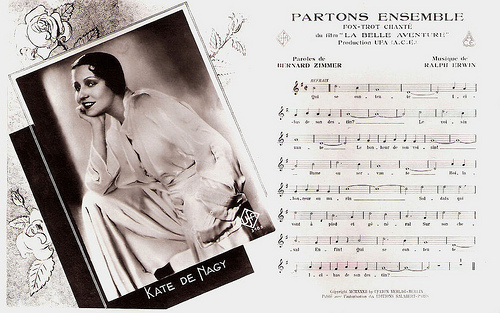
French postcard by P.C., Paris, no. 76. Photo: Ufa. Publicity still for La belle aventure/Beautiful Adventure (Roger Le Bon, Reinhold Schünzel, 1932), the French language version of Das schöne Abenteuer (Reinhold Schünzel, 1932).
France
Because of her multilingual education Käthe von Nagy was able to establish in the French cinema too. As Kate de Nagy she became a star in France.
To her French productions belong La Capitaine Craddock/Captain Craddock (Hanns Schwarz, Max de Vaucorbeil, 1931) with Jean Murat , La route impériale/The Imperial Road (Marcel L’Herbier, 1935) with Pierre Richard-Willm , Cargaison blanche/Woman Racket (Robert Siodmak, 1937) opposite Jules Berry , and La bataille silencieuse/The silent battle (Pierre Billon, 1937) starring Pierre Fresnay .
She withdrew from the film business with the beginning of World War II. After the war she appeared only twice on the screen, in the French drama Cargaison clandestine/Alarm in San Juano (Alfred Rode, 1948-1950) with Luis Mariano , and the German remake of Die Försterchristl/The Forester's Daughter (Arthur Maria Rabenalt, 1952), alongside Johanna Matz .
In the mid-1950s she went to California where she worked as a French teacher at Happy Valley School in Ojai, California.
Käthe von Nagy died of cancer in Ojai, USA in 1973. After her marriage to Constantin J. David, she was married to the Frenchman Jacques Fattini.
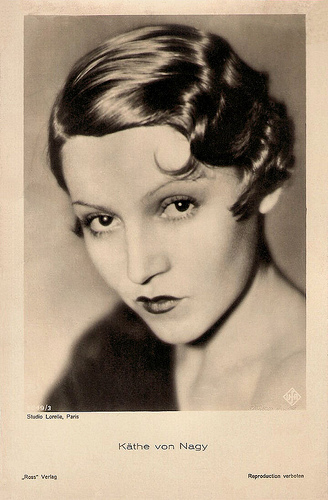
German postcard by Ross Verlag, no. 6849/3, 1931-1932. Photo: Studio Lorelle, Paris / Ufa.
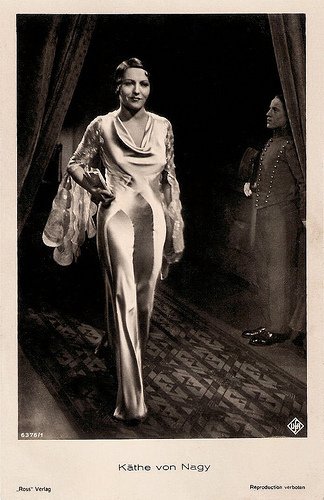
German postcard by Ross Verlag, no. 6376/1, 1931-1932. Photo: Ufa.
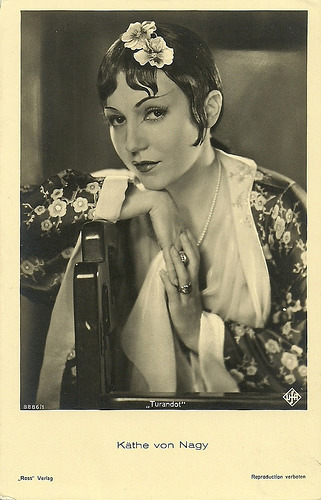
German postcard by Ross Verlag, no. 8886/1, 1933-1934. Photo: Ufa. Publicity still for Prinzessin Turandot/Princess Turandot (Gerhard Lamprecht, 1934).
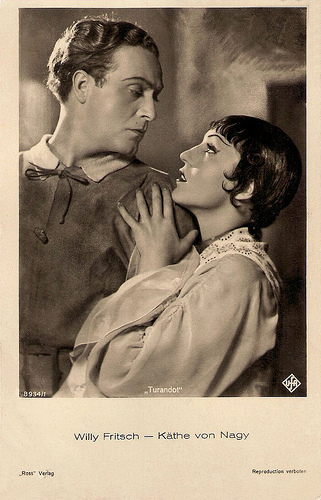
German postcard by Ross Verlag, no. 8934/1, 1933-1934. Photo: Ufa. Publicity still for Prinzessin Turandot/Princess Turandot (Gerhard Lamprecht, 1934) with Willy Fritsch .
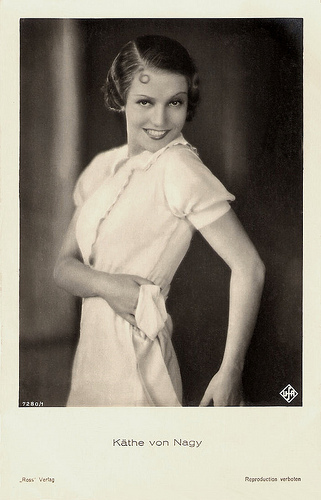
German postcard by Ross Verlag, no. 7280/1, 1932-1933. Photo: Ufa.
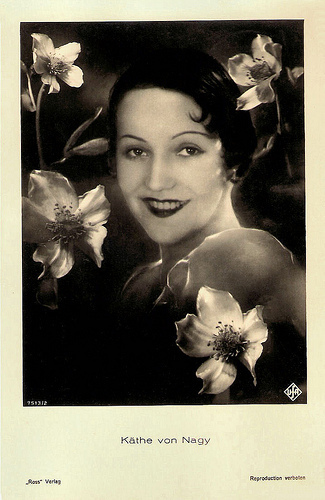
German postcard by Ross Verlag, no. 7513/2, 1932-1933. Photo: Ufa.
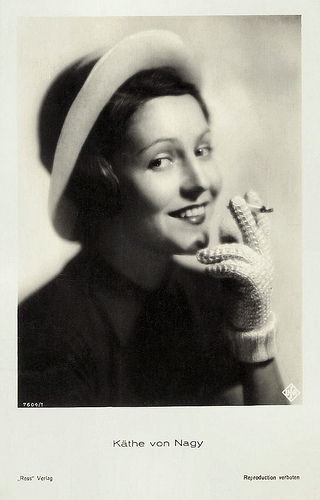
German postcard by Ross Verlag, no. 7604/1, 1932-1933. Photo: Ufa.
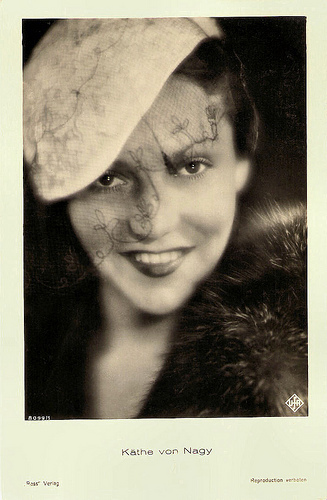
German postcard by Ross Verlag, no. 8099/1, 1933-1934. Photo: Ufa.
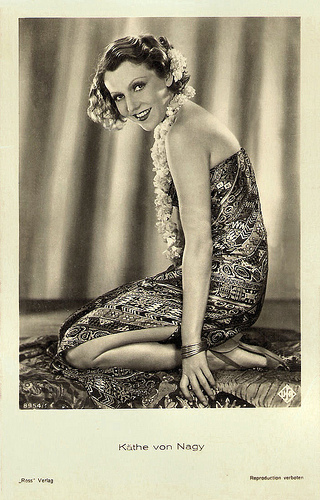
German postcard by Ross Verlag, no. 8954/1, 1933-1934. Photo: Ufa.
Sources: Thomas Staedeli (Cyranos), Operator 99 (Allure), Filmportal.de,Wikipedia, and .

German postcard by Ross Verlag, no. 5029/1, 1930-1931. Photo: Atelier Manassé, Vienna.

German postcard by Ross Verlag, no. 6107/1, 1931-1932. Photo: Ufa.

German postcard by Ross Verlag, no. 6850/2, 1931-1932. Photo: G.L. Manuel Frères, Paris / Ufa. Collection: Didier Hanson.

German postcard by Ross Verlag, no. 6972/1, 1931-1932. Photo: Ufa. Publicity still for Das schöne Abenteuer/Beautiful Adventure (Reinhold Schünzel, 1932).

German postcard by Ross Verlag, no. 7513/1, 1932-1933. Photo: Ufa.

German postcard by Ross Verlag, no. 8097/2, 1933-1934. Photo: Ufa.
Backfisch
Käthe von Nagy was born Ekaterina Nagy von Cziser (Kato Nagy) in Szabadka, Austria-Hungary (now: Subotica, Serbia) in 1904.
At the age of 16 she planned to get married and therefore her parents put her in the Sancta Christiana Convent near Vienna. After that, she worked in her father's bank office in Budapest and secretly started to write short stories for a newspaper. She also attended the acting school of director Béla Gáal and in 1926, against the will of her parents, she went to Berlin to make films.
While searching for an acting job she earned her money as a correspondent for the Hungarian newspaper Pester Hirlop. Hungarian director Alexander Korda helped her get her first film job. It was a supporting role in Männer von der Ehe/Men Before Marriage (Constantin J. David, 1927), which got her the reputation of a ‘backfisch’. The director, Constantin David, would also become her first husband.
Soon followed roles in Gustav Mond... Du gehst so stille/You Walk So Softly (Reinhold Schünzel, 1927) and Die Königin seines Herzens/Vienna, City of My Dreams (Victor Janson, 1928) starring Liane Haid .
With her first leading role in Die Durchgängerin/The Runaway Girl (Hanns Schwarz, 1928) she became the up-and-coming young actress of the European cinema of the 1920s. N
ext followed the Italian production Rotaie (Mario Camerini, 1929) and Mascottchen/Mascots (Felix Basch, 1929) with Jeanne Helbling .

German postcard by Ross Verlag, no. 5875/1, 1930-1931. Photo: Alex Binder.

German postcard by Ross Verlag, no. 6367/1, 1931-1932. Photo: Ufa.

German postcard by Ross Verlag, no. 6807/1, 1931-1932. Photo: Ufa.

German postcard by Ross Verlag, no. 6972/2, 1931-1932. Photo: Ufa.

German postcard by Ross Verlag, no. 6415/2, 1931-1932. Photo: Ufa / Frhr. v. Gudenburg.

German postcard by Ross Verlag, no. 7076/1, 1932-1933. Photo: Ufa.
The fashionable, elegant, a bit exotic type
In 1930, Käthe von Nagy smoothly moved into the talkies. She appeared as a resolute demimonde dame with psychotherapeutic powers in the Jekyll-and-Hyde-drama Der Andere/The Other (Robert Wiene, 1930), costarring Fritz Kortner and Heinrich George .
She said goodbye to her ‘backfisch’ image and impersonated frequently on the screen. Her operettas and musical comedies were very popular and confirmed her promise of the late 1920s.
To her successes of the 1930s belong Ihre Majestät die Liebe/Her Majesty Love (Joe May, 1930) with Franz Lederer , Meine Frau, die Hochstaplerin/My Wife, the Impostor (Kurt Gerron, 1931) opposite Heinz Rühmann , Ronny (Reinhold Schünzel, 1931), Ich bei Tag und Du bei Nacht/I by Day, You by Night (Ludwig Berger, 1932) opposite Willy Fritsch , Der Sieger/The Victor (Hans Hinrich, Paul Martin, 1932) with Hans Albers , Das Schöne Abenteuer/Beautiful Adventure (Reinhold Schünzel, 1932), the anti-Soviet propaganda film Flüchtlinge/Fugitives (Gustav Ucicky, 1933), Die Töchter ihrer Exzellenz/The daughters of Her Excellency (Reinhold Schünzel, 1934) and Salonwagen E 417/Luxury Train (Paul Verhoeven, 1939) with Paul Hörbiger .

German postcard by Ross Verlag, no. 6605/1, 1931-1932. Photo: Ufa. Publicity still for Der Sieger/The Winner (Paul Martin, Hans Hinrich, 1932) with Hans Albers .

German postcard by Ross Verlag, no. 6604/1, 1931-1932. Photo: Ufa. Publicity still for Der Sieger/The Winner (Paul Martin, Hans Hinrich, 1932) with Hans Albers .

German postcard by Ross Verlag, no. 7131/2, 1932-1933. Photo: Ufa. Publicity still for Le capitaine Craddock/Captain Craddock (Hanns Schwarz, Max de Vaucorbeil, 1931) with Jean Murat .

German postcard by Ross Verlag, no. 7535/1, 1932-1933. Photo: Ufa. Publicity still for À Moi le Jour, à Toi la Nuit/Day To Me, to You the Night (Ludwig Berger, Claude Heymann, 1932) with Fernand Gravey .

German postcard by Ross Verlag, no. 8822/1, 1933-1934. Photo: Ufa. Publicity still for Der junge Baron Neuhaus/The Young Baron Neuhaus (Gustav Ucicky, 1934) with Viktor de Kowa .

German postcard by Ross Verlag, no. 142/2. Photo: Günther Pilz / Ufa. Publicity still for Das Schöne Abenteuer/Beautiful Adventure (Reinhold Schünzel, 1932) with Wolf Albach-Retty .

German postcard by Ross Verlag, no. 142/6. Photo: Ufa. Publicity still for Das schöne Abenteuer/Beautiful Adventure (Reinhold Schünzel, 1932) with Wolf Albach-Retty .

French postcard by P.C., Paris, no. 76. Photo: Ufa. Publicity still for La belle aventure/Beautiful Adventure (Roger Le Bon, Reinhold Schünzel, 1932), the French language version of Das schöne Abenteuer (Reinhold Schünzel, 1932).
France
Because of her multilingual education Käthe von Nagy was able to establish in the French cinema too. As Kate de Nagy she became a star in France.
To her French productions belong La Capitaine Craddock/Captain Craddock (Hanns Schwarz, Max de Vaucorbeil, 1931) with Jean Murat , La route impériale/The Imperial Road (Marcel L’Herbier, 1935) with Pierre Richard-Willm , Cargaison blanche/Woman Racket (Robert Siodmak, 1937) opposite Jules Berry , and La bataille silencieuse/The silent battle (Pierre Billon, 1937) starring Pierre Fresnay .
She withdrew from the film business with the beginning of World War II. After the war she appeared only twice on the screen, in the French drama Cargaison clandestine/Alarm in San Juano (Alfred Rode, 1948-1950) with Luis Mariano , and the German remake of Die Försterchristl/The Forester's Daughter (Arthur Maria Rabenalt, 1952), alongside Johanna Matz .
In the mid-1950s she went to California where she worked as a French teacher at Happy Valley School in Ojai, California.
Käthe von Nagy died of cancer in Ojai, USA in 1973. After her marriage to Constantin J. David, she was married to the Frenchman Jacques Fattini.

German postcard by Ross Verlag, no. 6849/3, 1931-1932. Photo: Studio Lorelle, Paris / Ufa.

German postcard by Ross Verlag, no. 6376/1, 1931-1932. Photo: Ufa.

German postcard by Ross Verlag, no. 8886/1, 1933-1934. Photo: Ufa. Publicity still for Prinzessin Turandot/Princess Turandot (Gerhard Lamprecht, 1934).

German postcard by Ross Verlag, no. 8934/1, 1933-1934. Photo: Ufa. Publicity still for Prinzessin Turandot/Princess Turandot (Gerhard Lamprecht, 1934) with Willy Fritsch .

German postcard by Ross Verlag, no. 7280/1, 1932-1933. Photo: Ufa.

German postcard by Ross Verlag, no. 7513/2, 1932-1933. Photo: Ufa.

German postcard by Ross Verlag, no. 7604/1, 1932-1933. Photo: Ufa.

German postcard by Ross Verlag, no. 8099/1, 1933-1934. Photo: Ufa.

German postcard by Ross Verlag, no. 8954/1, 1933-1934. Photo: Ufa.
Sources: Thomas Staedeli (Cyranos), Operator 99 (Allure), Filmportal.de,Wikipedia, and .
Published on April 30, 2015 22:00
April 29, 2015
Harry Liedtke
German actor Harry Liedtke (1882-1945) was the charming ladykiller of many early silent classics. Detective serials like Joe Deebs made him one of the first male stars of the German cinema.
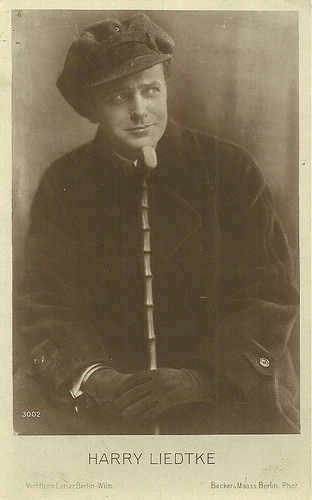
German postcard by Verlag Hermann Leiser, Berlin, no. 3002. Photo Becker & Maass, Berlin.
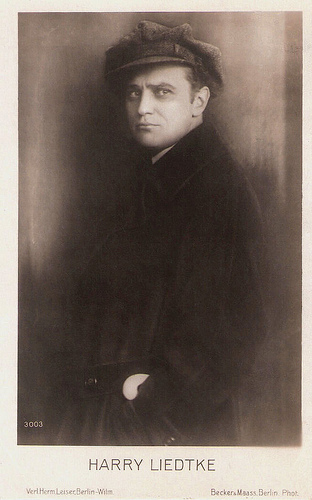
German postcard by Verlag Hermann Leiser, Berlin-Wilm., no. 3003. Photo: Becker & Maass, Berlin.
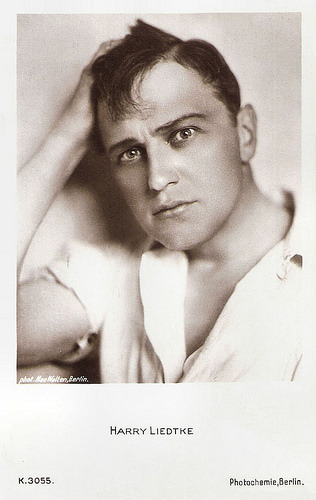
German postcard by Photochemie, Berlin, no. K. 3055. Photo: Mac Walten, Berlin.
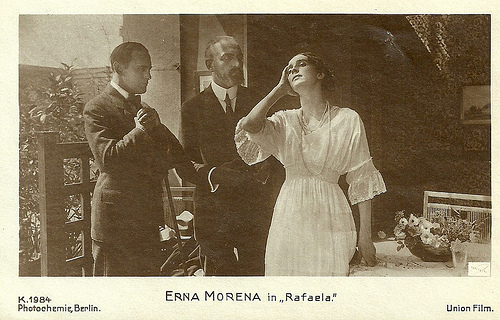
German postcard by Photochemie, Berlin, no. K. 1984. Photo: Union-Film. Erna Morena, Harry Liedtke and Magnus Stifter in Rafaela/Wer weiss? (Arsen von Cserépy, 1917).
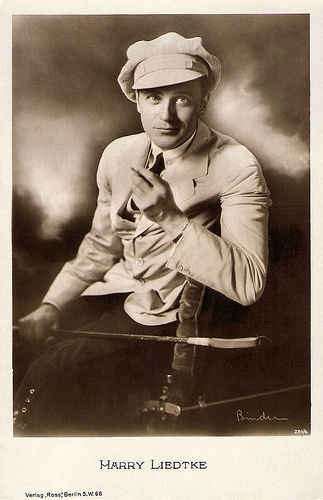
German postcard by Ross Verlag, no. 284/4, 1919-1924. Photo: Atelier Binder, Berlin.
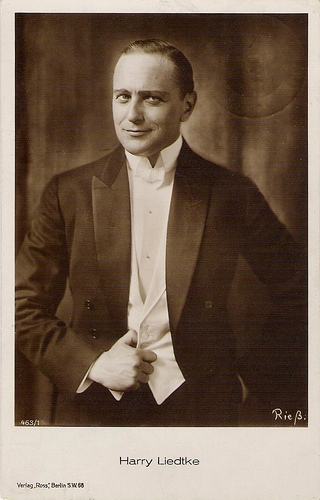
German postcard by Ross Verlag, no. 463/1, 1919-1924. Photo: Riess.
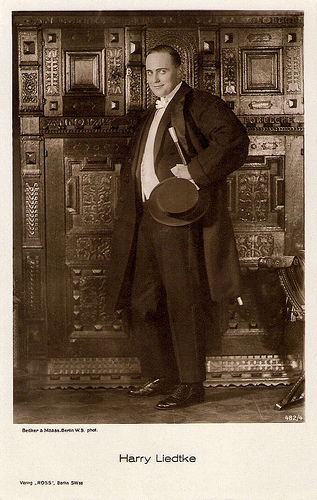
German postcard by Ross Verlag, no. 482/1, 1919-1924. Photo: Becker & Maass, Berlin.
Elegant Gentleman
Harry Liedtke was born in Königsberg, East Prussia (today: Kaliningrad, Russia) in 1882. He was the seventh of eleven children of an import and export merchant who dealt with linseed and hemp. After the death of his father in 1896, he grew up in an orphanage and began a qualification in retail business.
During a visit to Berlin, Liedtke met Hans Oberländer, the artistic director of Königliches Schauspielhaus. After several acting lessons, he became a cast member at Stadttheater Freiberg, Saxony. He had some more theatre engagements, and in 1908 he went to New York for one year to play at the New German Theatre.
After his return in Germany his career finally got ahead with engagements at the Hof- und Nationaltheater in Mannheim and the Residenz-Theater and Deutschen Theater in Berlin.
Very early he came in contact with the medium film. In 1912 he made his film debut in Zu spät/Too Late (Carl Froelich, 1912), produced by film pioneer Oskar Messter. In the following years he personified the elegant gentleman and youthful charmer in many productions of the Messter studio, like Eva (Curt A. Stark, 1913) starring Henny Porten , and Schuldig/Guilty (Hans Oberländer, 1914) with Leopoldine Konstantin.
In 1916 he became a widely popular star as the detective Joe Deebs in short adventure films like Wie ich Detektiv wurde/How I Became Detective (Joe May, 1916), and Das Rätselhafte Inserat/The Mysterious Advertisement (Karl Gerhardt, Joe May, 1916).
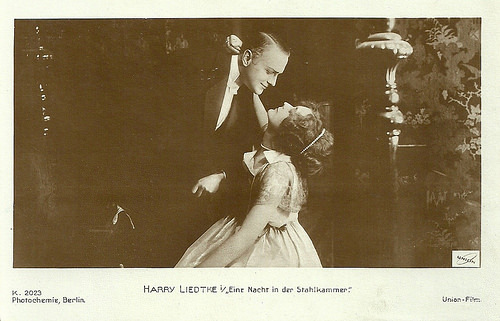
German postcard by Photochemie, Berlin, no. K. 2023. Photo: Union-Film. Harry Liedtke in the film Eine Nacht in der Stahlkammer/A night in the vault (Felix Basch, 1917).
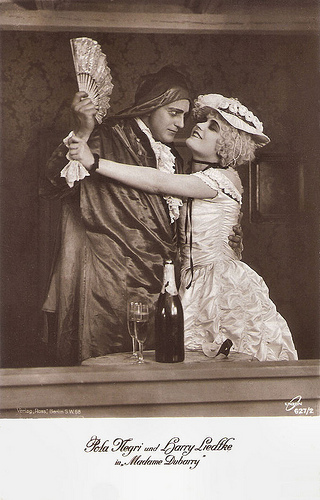
German postcard by Ross Verlag, Berlin, no. 627/2, 1919-1924. Photo: Union. Publicity still for Madame DuBarry (Ernst Lubitsch, 1919) with Pola Negri .
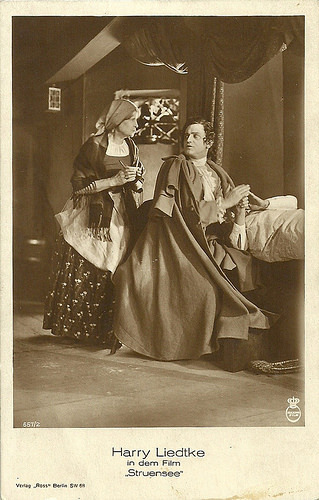
German postcard by Ross Verlag, no. 657/2. Photo: Maxim Film. Harry Liedtke as Johan Friedrich Struensee, physician and lover of the Danish queen (Henny Porten) in Struensee/Der Liebe einer Königin (Ludwig Wolff, 1923).
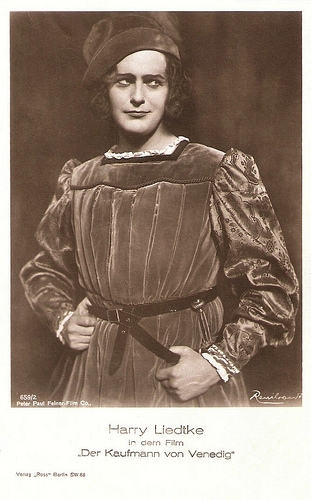
German postcard by Ross Verlag, no. 659/2, 1919-1924. Photo: Rembrandt / Peter Paul Felner Film Co. Publicity still for Der Kaufmann von Venedig/The Merchant Of Venice (Peter Paul Felner, 1923).
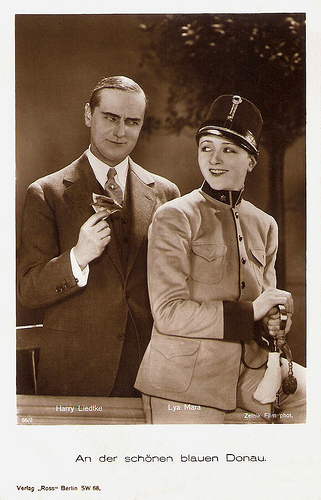
German postcard by Ross Verlag, no. 56/2, 1925-1926. Photo: Zelnik Film. Publicity still for An der schönen blauen Donau/The Beautiful Blue Danube (Friedrich Zelnik, 1926) with Lya Mara . Collection: Egbert Barten.
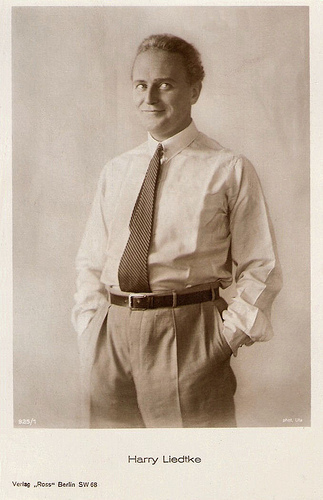
German postcard by Ross Verlag, Berlin, no. 925/1, 1925-1926. Photo: Ufa.
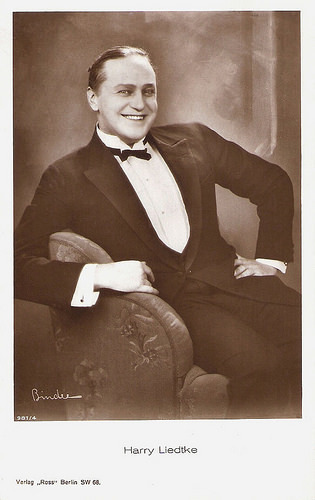
German postcard by Ross Verlag, Berlin, no. 981/4, 1925-1926. Photo: Alex Binder.
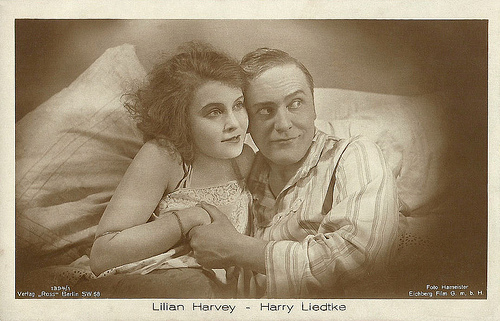
German postcard by Ross Verlag, no. 1394/1, 1927-1928. Photo: Hameister - Eichberg Film G.m.b.H. Publicity still for Liebe und Trompetenblasen (Richard Eichberg, 1925) with Lilian Harvey . Collection: Didier Hanson.
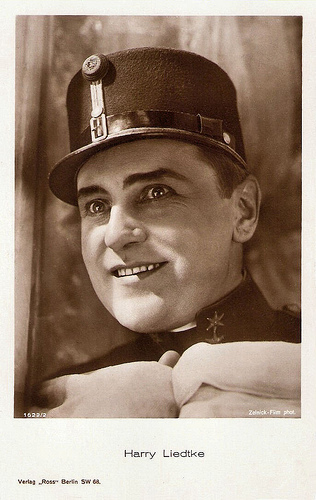
German postcard by Ross Verlag, Berlin, no. 1622/2, 1927-1928. Photo: Zelnick-Film.
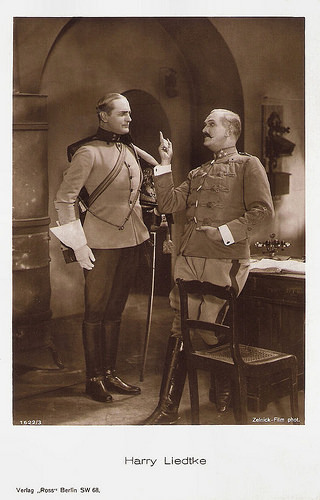
German postcard by Ross Verlag, Berlin, no. 1622/3, 1927-1928. Photo: Zelnick Film.
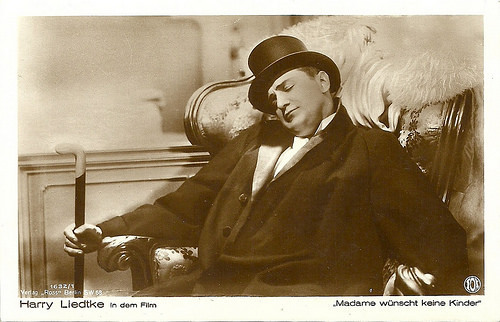
German postcard by Ross Verlag, no. 1632/1. Photo: Fox. Harry Liedtke in Madame wünscht keine Kinder (Alexander Korda, 1926).
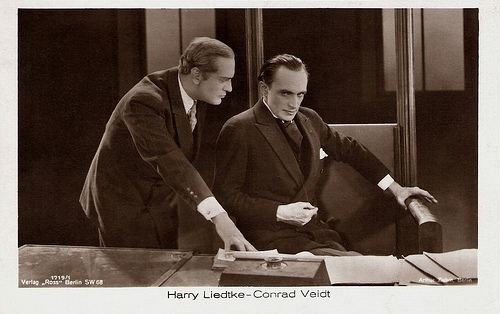
German postcard by Ross Verlag, Berlin, no. 1719/1, 1927-1928. Photo: Arthur Ziehm, Berlin. Publicity still for Kreuzzug des Weibes/The Wife's Crusade (Martin Berger, 1926) with Conrad Veidt .
Lubitsch
Now, famous directors wanted Harry Liedtke for their films, and he developed into one of the first male stars of the German cinema.
With director Paul Leni, he made Prima Vera/Camille (1917) opposite Erna Morena , Dornröschen/The Sleeping Beauty (1917) with his wife Käthe Dorsch , and Das Rätsel von Bangalor/The Mystery of Bangalore (Paul Leni, Alexander Antalffy, 1918) with Conrad Veidt .
With Ernst Lubitsch he celebrated great successes in the Fledermaus-adaptation Das fidele Gefängnis/The Merry Jail (1917) with Ossi Oswalda , Der Rodelkavalier (1918), Die Augen der Mumie Ma/The Eyes of the Mummy Ma (1918) with Emil Jannings , Das Mädel vom Ballet/The Ballet Girl (1918), Carmen (1918) with Pola Negri , Die Austernprinzessin/The Oyster Princess (1919), Madame Dubarry (1919), Sumurun/One Arabian Night (1920), and Das Weib des Pharao/The Wife of the Pharaoh (1922) with Dagny Servaes .
Other popular films were the Frank Wedekind adaptation Lulu (Alexander Antalffy, 1917) with Erna Morena , the Detective series Der Mann ohne Namen/The Man Without a Name (Georg Jacoby, 1921), the comedy Die Finanzen des Grossherzogs/The Grand Duke's Finances (F.W. Murnau, 1924) starring Alfred Abel , Nanon (Hanns Schwarz, 1924) starring countess Agnes Esterhazy , and Der Feldherrnhügel (1926) with Olga Tschechova .

German postcard by Ross Verlag, Berlin, no. 91/1. Photo: Aafa. Publicity still for Der Bettelstudent/The Beggar Student (Jacob Fleck, Luise Fleck, 1927) with Agnes Estherhazy .
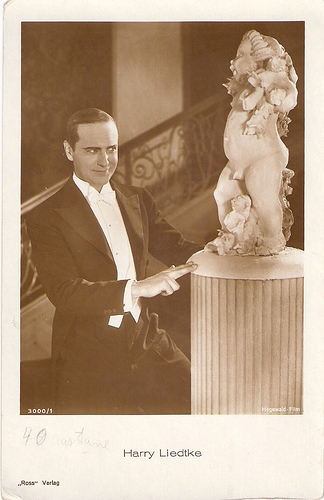
German postcard by Ross Verlag, no. 3000/1, 1928. Photo: Hegewald-Film. Harry Liedtke starred in the Hegewald-Film production Das Fürstenkind (Jakob and Luise Fleck, 1927).
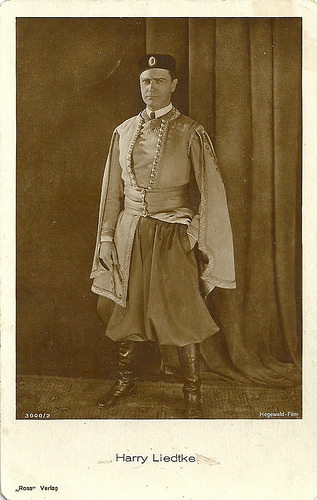
German postcard by Ross Verlag, no. 3000/2, 1928. Photo: Hegewald-Film.
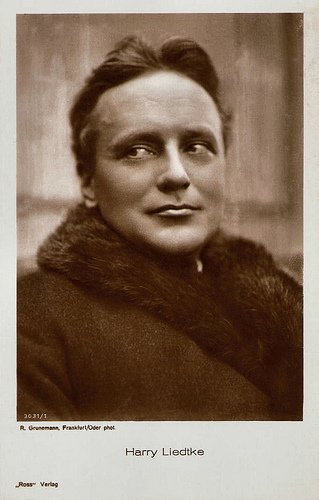
German postcard by Ross Verlag, Berlin, no. 3033/1, 1928-1929. Photo: R. Grunemann, Frankfurt/Oder.
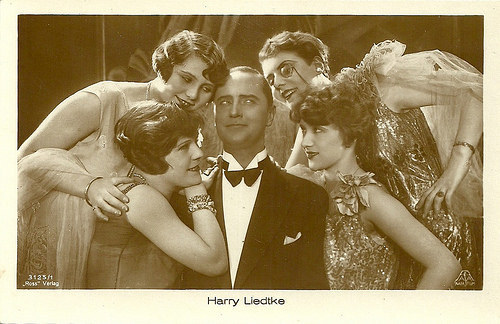
German postcard by Ross Verlag, no. 3125/1, 1928-1929. Photo: Aafa Film.
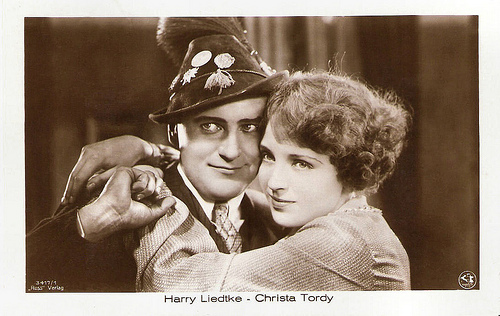
German postcard by Ross Verlag, Berlin, no. 3417/1, 1928-1929. Photo: Phoebus-Film AG. Publicity still for Amor auf Ski/Cupid on skis (Rolf Randolf, 1928) with Christa Tordy.
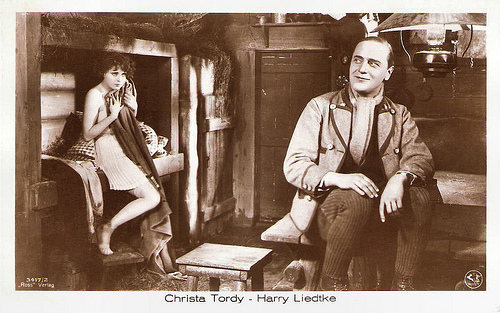
German postcard by Ross Verlag, no. 3417/2, 1928-1929. Photo: Phoebus-Film. Publicity still with Harry Liedtke and Christa Tordy in Amor auf Ski/Cupid on skis (Rolf Randolf, 1928).
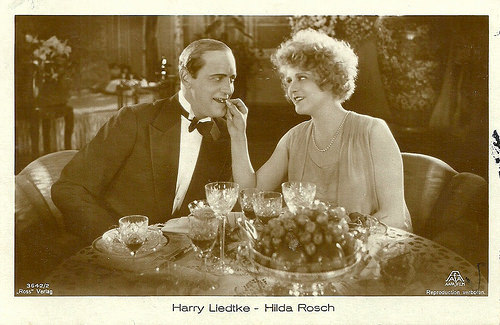
German postcard by Ross Verlag, no. 3642/2, 1928-1929. Photo: Aafa Film. Publicity still for Das Spiel mit der Liebe/The Game of Love (Victor Janson, 1928) with Hilda Rosch .
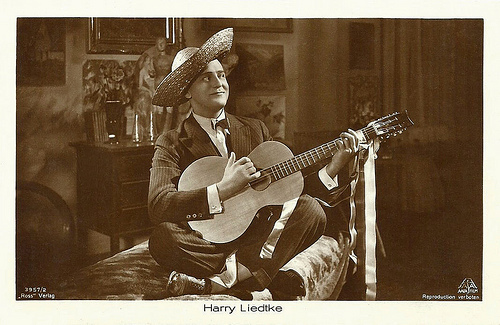
German postcard by Ross Verlag, no. 3957/2, 1928-1929. Photo: Aafa Film. Publicity still for Der Faschingsprinz/The carnival prince (Rudolf Walther-Fein, 1928).
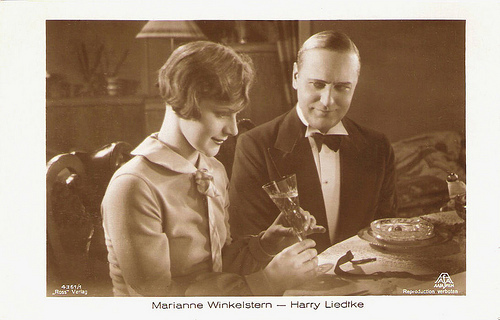
German postcard by Ross Verlag, no. 4361/1, 1929-1930. Photo: Alex Binder, Berlin. Publicity still for Die Zirkusprinzessin/The Circus Princess (Victor Janson, 1929) with Marianne Winkelstern .
Silent Operettas
In the second half of the 1920s, Harry Liedtke appeared in many silent operettas such as Liebe und Trompetenblasen/Love and Trumpet Playing (Richard Eichberg, 1925) with Lilian Harvey , Die Försterchristel/The Bohemian Dancer (Friedrich Zelnik, 1926) with Lya Mara , and Ich küsse Ihre Hand, Madame/I Kiss Your Hand Madame (Robert Land, 1929) with Marlene Dietrich .
When the sound film arrived Liedtke’s career slackened off. His voice turned out to be unsuitable. He got supporting roles in such films as Preußische Liebesgeschichte/A Prussian Love Story (Paul Martin, 1938) with Willy Fritsch , and Quax, der Bruchpilot/Quax, the Crashing Pilot (Kurt Hoffmann, 1941), but leading roles were left over more rarely.
He changed inevitably from a ladykiller to a graying gentleman. With his leading role in the comedy Sophienlund (Heinz Rühmann, 1942) he could prove his acting skills. His final role was the lead in Das Konzert/The Concert (Paul Verhoeven, 1944).
During the invasion of the Red Army in April 1945 Harry Liedtke and his third wife, actress Christa Tordy were murdered by Soviet soldiers in their own house in Bad Saarow-Pieskow. One of the Russians smashed a bottle over Liedtke's head when he tried to save his wife from being raped.
Harry Liedtke first had been married to Hanne Schutt. From 1920 till 1928, Liedtke was married to the actress Käthe Dorsch .
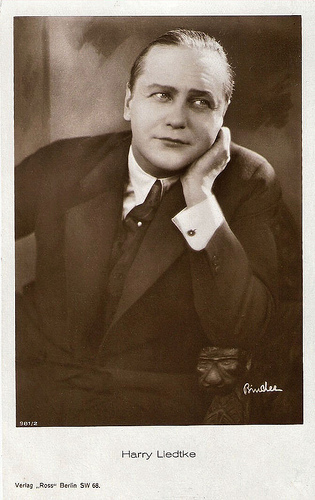
German postcard by Ross Verlag, no. 981/2, 1925-1926. Photo: Alex Binder, Berlin.
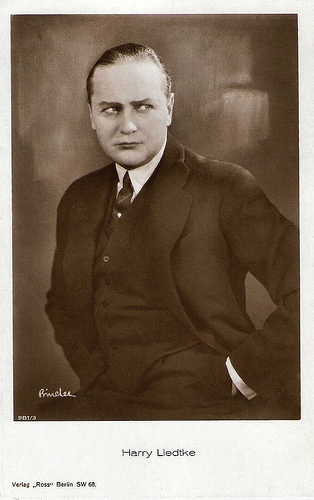
German postcard by Ross Verlag, no. 981/3, 1925-1926. Photo: Alex Binder.
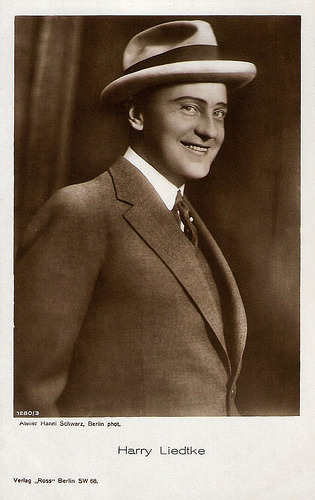 >
>
German postcard by Ross Verlag, Berlin, no. 1280/3, 1927-1928. Photo: Hanni Schwarz, Berlin.
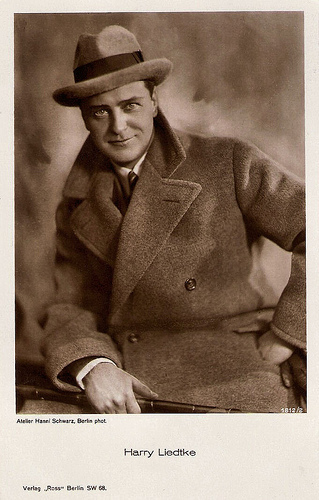
German postcard by Ross Verlag, Berlin, no. 1812/2, 1927-1928. Photo: Hanni Schwarz, Berlin.
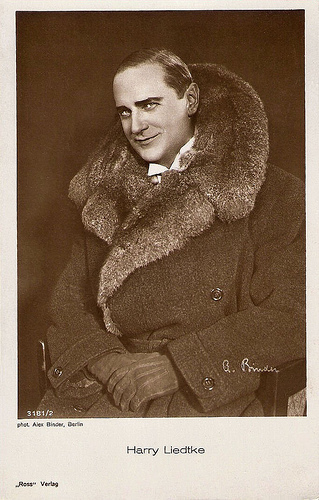
German postcard by Ross Verlag, no. 3181/2, 1928-1929. Photo: Alex Binder, Berlin.
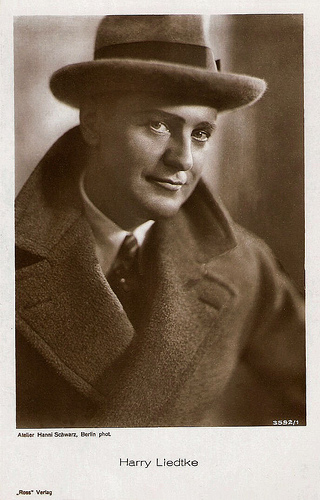
German postcard by Ross Verlag, no. 3592/1, 1928-1929. Photo: Hanni Schwarz, Berlin.
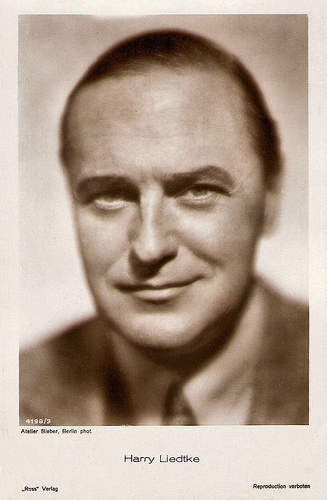
German postcard by Ross Verlag, no. 4189/3, 1929-1930. Photo: Atelier Binder, Berlin.
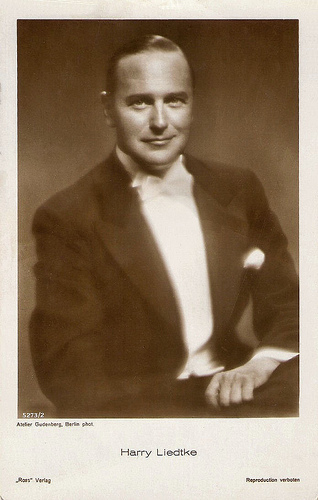
German postcard by Ross Verlag, no. 5273/2, 1930-1931. Photo: Atelier Guldenberg, Berlin.
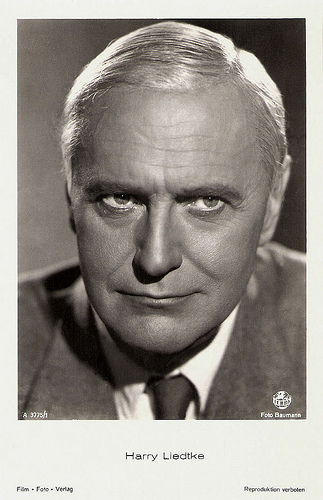
German postcard by Film-Foto-Verlag, Berlin, no. A 3775/1, 1941-1944. Photo: Baumann / Terra.
Sources: Thomas Staedeli (Cyranos), Stephanie D'heil (Steffi-line - German), Wikipedia (German), Filmportal.de and .

German postcard by Verlag Hermann Leiser, Berlin, no. 3002. Photo Becker & Maass, Berlin.

German postcard by Verlag Hermann Leiser, Berlin-Wilm., no. 3003. Photo: Becker & Maass, Berlin.

German postcard by Photochemie, Berlin, no. K. 3055. Photo: Mac Walten, Berlin.

German postcard by Photochemie, Berlin, no. K. 1984. Photo: Union-Film. Erna Morena, Harry Liedtke and Magnus Stifter in Rafaela/Wer weiss? (Arsen von Cserépy, 1917).

German postcard by Ross Verlag, no. 284/4, 1919-1924. Photo: Atelier Binder, Berlin.

German postcard by Ross Verlag, no. 463/1, 1919-1924. Photo: Riess.

German postcard by Ross Verlag, no. 482/1, 1919-1924. Photo: Becker & Maass, Berlin.
Elegant Gentleman
Harry Liedtke was born in Königsberg, East Prussia (today: Kaliningrad, Russia) in 1882. He was the seventh of eleven children of an import and export merchant who dealt with linseed and hemp. After the death of his father in 1896, he grew up in an orphanage and began a qualification in retail business.
During a visit to Berlin, Liedtke met Hans Oberländer, the artistic director of Königliches Schauspielhaus. After several acting lessons, he became a cast member at Stadttheater Freiberg, Saxony. He had some more theatre engagements, and in 1908 he went to New York for one year to play at the New German Theatre.
After his return in Germany his career finally got ahead with engagements at the Hof- und Nationaltheater in Mannheim and the Residenz-Theater and Deutschen Theater in Berlin.
Very early he came in contact with the medium film. In 1912 he made his film debut in Zu spät/Too Late (Carl Froelich, 1912), produced by film pioneer Oskar Messter. In the following years he personified the elegant gentleman and youthful charmer in many productions of the Messter studio, like Eva (Curt A. Stark, 1913) starring Henny Porten , and Schuldig/Guilty (Hans Oberländer, 1914) with Leopoldine Konstantin.
In 1916 he became a widely popular star as the detective Joe Deebs in short adventure films like Wie ich Detektiv wurde/How I Became Detective (Joe May, 1916), and Das Rätselhafte Inserat/The Mysterious Advertisement (Karl Gerhardt, Joe May, 1916).

German postcard by Photochemie, Berlin, no. K. 2023. Photo: Union-Film. Harry Liedtke in the film Eine Nacht in der Stahlkammer/A night in the vault (Felix Basch, 1917).

German postcard by Ross Verlag, Berlin, no. 627/2, 1919-1924. Photo: Union. Publicity still for Madame DuBarry (Ernst Lubitsch, 1919) with Pola Negri .

German postcard by Ross Verlag, no. 657/2. Photo: Maxim Film. Harry Liedtke as Johan Friedrich Struensee, physician and lover of the Danish queen (Henny Porten) in Struensee/Der Liebe einer Königin (Ludwig Wolff, 1923).

German postcard by Ross Verlag, no. 659/2, 1919-1924. Photo: Rembrandt / Peter Paul Felner Film Co. Publicity still for Der Kaufmann von Venedig/The Merchant Of Venice (Peter Paul Felner, 1923).

German postcard by Ross Verlag, no. 56/2, 1925-1926. Photo: Zelnik Film. Publicity still for An der schönen blauen Donau/The Beautiful Blue Danube (Friedrich Zelnik, 1926) with Lya Mara . Collection: Egbert Barten.

German postcard by Ross Verlag, Berlin, no. 925/1, 1925-1926. Photo: Ufa.

German postcard by Ross Verlag, Berlin, no. 981/4, 1925-1926. Photo: Alex Binder.

German postcard by Ross Verlag, no. 1394/1, 1927-1928. Photo: Hameister - Eichberg Film G.m.b.H. Publicity still for Liebe und Trompetenblasen (Richard Eichberg, 1925) with Lilian Harvey . Collection: Didier Hanson.

German postcard by Ross Verlag, Berlin, no. 1622/2, 1927-1928. Photo: Zelnick-Film.

German postcard by Ross Verlag, Berlin, no. 1622/3, 1927-1928. Photo: Zelnick Film.

German postcard by Ross Verlag, no. 1632/1. Photo: Fox. Harry Liedtke in Madame wünscht keine Kinder (Alexander Korda, 1926).

German postcard by Ross Verlag, Berlin, no. 1719/1, 1927-1928. Photo: Arthur Ziehm, Berlin. Publicity still for Kreuzzug des Weibes/The Wife's Crusade (Martin Berger, 1926) with Conrad Veidt .
Lubitsch
Now, famous directors wanted Harry Liedtke for their films, and he developed into one of the first male stars of the German cinema.
With director Paul Leni, he made Prima Vera/Camille (1917) opposite Erna Morena , Dornröschen/The Sleeping Beauty (1917) with his wife Käthe Dorsch , and Das Rätsel von Bangalor/The Mystery of Bangalore (Paul Leni, Alexander Antalffy, 1918) with Conrad Veidt .
With Ernst Lubitsch he celebrated great successes in the Fledermaus-adaptation Das fidele Gefängnis/The Merry Jail (1917) with Ossi Oswalda , Der Rodelkavalier (1918), Die Augen der Mumie Ma/The Eyes of the Mummy Ma (1918) with Emil Jannings , Das Mädel vom Ballet/The Ballet Girl (1918), Carmen (1918) with Pola Negri , Die Austernprinzessin/The Oyster Princess (1919), Madame Dubarry (1919), Sumurun/One Arabian Night (1920), and Das Weib des Pharao/The Wife of the Pharaoh (1922) with Dagny Servaes .
Other popular films were the Frank Wedekind adaptation Lulu (Alexander Antalffy, 1917) with Erna Morena , the Detective series Der Mann ohne Namen/The Man Without a Name (Georg Jacoby, 1921), the comedy Die Finanzen des Grossherzogs/The Grand Duke's Finances (F.W. Murnau, 1924) starring Alfred Abel , Nanon (Hanns Schwarz, 1924) starring countess Agnes Esterhazy , and Der Feldherrnhügel (1926) with Olga Tschechova .

German postcard by Ross Verlag, Berlin, no. 91/1. Photo: Aafa. Publicity still for Der Bettelstudent/The Beggar Student (Jacob Fleck, Luise Fleck, 1927) with Agnes Estherhazy .

German postcard by Ross Verlag, no. 3000/1, 1928. Photo: Hegewald-Film. Harry Liedtke starred in the Hegewald-Film production Das Fürstenkind (Jakob and Luise Fleck, 1927).

German postcard by Ross Verlag, no. 3000/2, 1928. Photo: Hegewald-Film.

German postcard by Ross Verlag, Berlin, no. 3033/1, 1928-1929. Photo: R. Grunemann, Frankfurt/Oder.

German postcard by Ross Verlag, no. 3125/1, 1928-1929. Photo: Aafa Film.

German postcard by Ross Verlag, Berlin, no. 3417/1, 1928-1929. Photo: Phoebus-Film AG. Publicity still for Amor auf Ski/Cupid on skis (Rolf Randolf, 1928) with Christa Tordy.

German postcard by Ross Verlag, no. 3417/2, 1928-1929. Photo: Phoebus-Film. Publicity still with Harry Liedtke and Christa Tordy in Amor auf Ski/Cupid on skis (Rolf Randolf, 1928).

German postcard by Ross Verlag, no. 3642/2, 1928-1929. Photo: Aafa Film. Publicity still for Das Spiel mit der Liebe/The Game of Love (Victor Janson, 1928) with Hilda Rosch .

German postcard by Ross Verlag, no. 3957/2, 1928-1929. Photo: Aafa Film. Publicity still for Der Faschingsprinz/The carnival prince (Rudolf Walther-Fein, 1928).

German postcard by Ross Verlag, no. 4361/1, 1929-1930. Photo: Alex Binder, Berlin. Publicity still for Die Zirkusprinzessin/The Circus Princess (Victor Janson, 1929) with Marianne Winkelstern .
Silent Operettas
In the second half of the 1920s, Harry Liedtke appeared in many silent operettas such as Liebe und Trompetenblasen/Love and Trumpet Playing (Richard Eichberg, 1925) with Lilian Harvey , Die Försterchristel/The Bohemian Dancer (Friedrich Zelnik, 1926) with Lya Mara , and Ich küsse Ihre Hand, Madame/I Kiss Your Hand Madame (Robert Land, 1929) with Marlene Dietrich .
When the sound film arrived Liedtke’s career slackened off. His voice turned out to be unsuitable. He got supporting roles in such films as Preußische Liebesgeschichte/A Prussian Love Story (Paul Martin, 1938) with Willy Fritsch , and Quax, der Bruchpilot/Quax, the Crashing Pilot (Kurt Hoffmann, 1941), but leading roles were left over more rarely.
He changed inevitably from a ladykiller to a graying gentleman. With his leading role in the comedy Sophienlund (Heinz Rühmann, 1942) he could prove his acting skills. His final role was the lead in Das Konzert/The Concert (Paul Verhoeven, 1944).
During the invasion of the Red Army in April 1945 Harry Liedtke and his third wife, actress Christa Tordy were murdered by Soviet soldiers in their own house in Bad Saarow-Pieskow. One of the Russians smashed a bottle over Liedtke's head when he tried to save his wife from being raped.
Harry Liedtke first had been married to Hanne Schutt. From 1920 till 1928, Liedtke was married to the actress Käthe Dorsch .

German postcard by Ross Verlag, no. 981/2, 1925-1926. Photo: Alex Binder, Berlin.

German postcard by Ross Verlag, no. 981/3, 1925-1926. Photo: Alex Binder.
 >
>German postcard by Ross Verlag, Berlin, no. 1280/3, 1927-1928. Photo: Hanni Schwarz, Berlin.

German postcard by Ross Verlag, Berlin, no. 1812/2, 1927-1928. Photo: Hanni Schwarz, Berlin.

German postcard by Ross Verlag, no. 3181/2, 1928-1929. Photo: Alex Binder, Berlin.

German postcard by Ross Verlag, no. 3592/1, 1928-1929. Photo: Hanni Schwarz, Berlin.

German postcard by Ross Verlag, no. 4189/3, 1929-1930. Photo: Atelier Binder, Berlin.

German postcard by Ross Verlag, no. 5273/2, 1930-1931. Photo: Atelier Guldenberg, Berlin.

German postcard by Film-Foto-Verlag, Berlin, no. A 3775/1, 1941-1944. Photo: Baumann / Terra.
Sources: Thomas Staedeli (Cyranos), Stephanie D'heil (Steffi-line - German), Wikipedia (German), Filmportal.de and .
Published on April 29, 2015 22:00
April 28, 2015
A. Noyer
From the 1910s till after the Second World War, A.N. or A. Noyer was a large French photo studio and postcard publisher. A.N. produced the beautiful series Les Vedettes de Cinema with ca. 1300 star postcards.

Stacia Napierkowska . French postcard by A.N., Paris, in the series Les Vedettes de Cinéma, no. 50. Photo: Sobol.
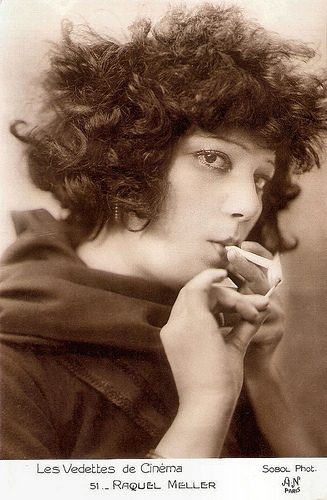
Raquel Meller . French postcard by A.N., Paris, in the series Les Vedettes de Cinéma, no. 51. Sent by mail in 1925. Photo: Sobol.
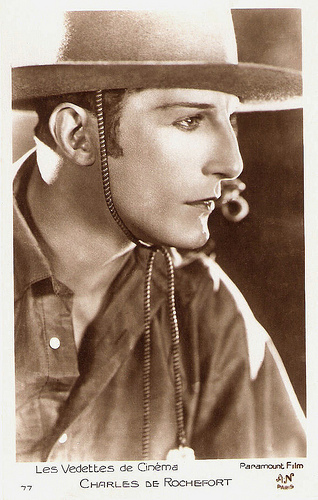
Charles de Rochefort . French postcard by A.N., Paris, in the series Les Vedettes de Cinéma, no. 77. Photo: Paramount Film.
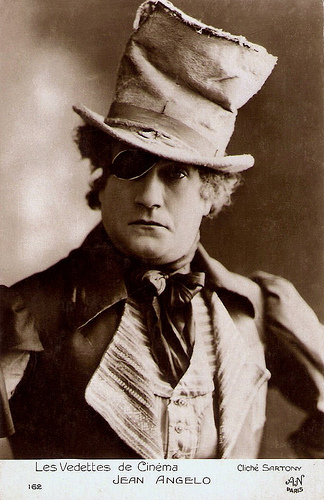
Jean Angelo . French postcard by A.N., Paris, in the series Les Vedettes de Cinéma, no. 162. Photo: Sartony.
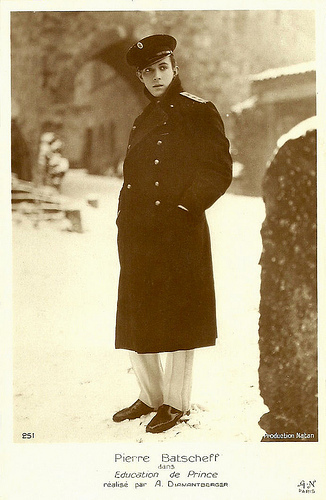
French postcard by A.N. Paris, in the series Les Vedettes de Cinéma, no. 251. Photo: Production Natan. Publicity still of Pierre Batcheff in Education de prince (Henri Diamant-Berger, 1927). Collection: Didier Hanson.
Armand Noyer
A.N. or A. Noyer stood for Armand Noyer, and not for Alfred Noyer, as many sources write. He was a well known French photographer in the early 20th Century. His company was located at the Boulevard de Strasbourg in Paris.
In the early 1910s, Noyer started to make postcards. Many of his early cards were photo reproductions of drawn, painted, or sculpted artworks printed in halftone lithography. Noyer was a member of the Salon de Paris and photographed paintings for the Salon and other institutions, which he also used for the production of his art cards.
Armand Noyer’s boldly hand colored seaside figures became his most recognized style. Many of his photos from this time were heavily toned in blue or sepia. Noyer also produced illustrated photo cards of the First World War, many with heavy patriotic or allegorical themes.
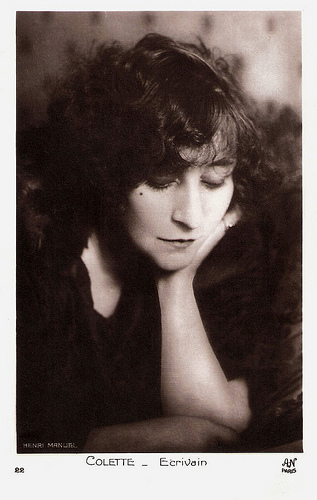
The novelist and performer Colette. French postcard by A.N. Paris, no. 22. Photo: Henri Manuel.
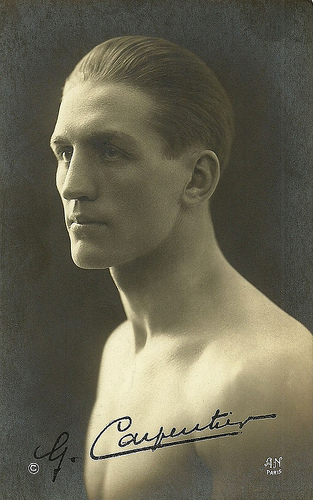
French boxer and war hero Georges Carpentier . French postcard by A.N., Paris. Collection: Didier Hanson.
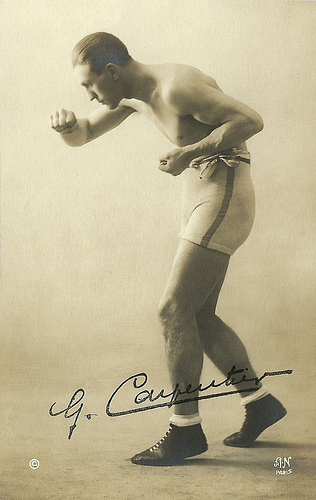
Georges Carpentier. French postcard by A.N., Paris. Collection: Didier Hanson.
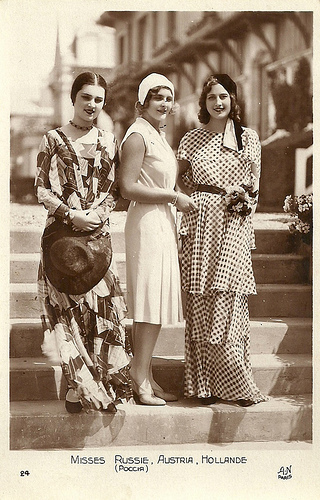
Miss Europe candidates 1930: the Misses Russia, Austria, and Holland. French postcard by A.N., Paris, no. 24. Left Irene Wentzel (aka Irene Wentzell aka Irina Veisel) was Miss Russia in Paris in 1930, elected by Russian immigrants, so she joined the 1930 Miss Europe pageant in Paris. Centre Ingeborg von Grinberger aka Grienberger was Miss Austria 1930, so she also joined the Miss Europe contest. Just like in 1929, the Austrian daily Das neue Wiener Tagblatt had organised the pageant. She originally came from the Austrian province of Steiermark. Most right is Rie van der Rest, the 1930 Miss Holland.
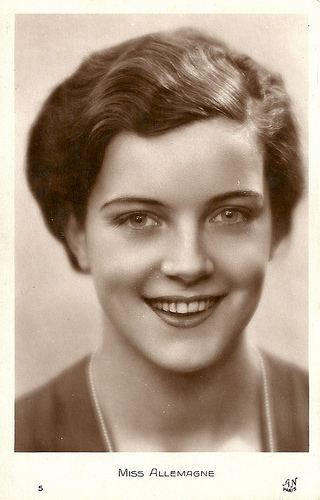
Miss Germany 1930: Dorit Nitykowski. French postcard by A.N., Paris, no. 5. Dorit Nitykowski, born 1911 in Berlin, was crowned Miss Germany in 1930 at the Berlin Kaiserhof. She could join the 1930 Miss Europe contest in Paris. Winner that year was Miss Greece: Aliki Diplarakou. Nitykowski also participated in the 1930 Miss Universe contest in Rio de Janeiro. She had to give back her title of Miss Germany, as she married the star pilot Rudolf Cramer von Clausbruch before her one-year existence of Miss Germany had ended.
Boudoir Cards
By the 1920s Armand Noyer began producing cards of children and women, many of which were nudes or risque images. Some sites call them 'boudoir cards', a popular genre since the Belle Epoque.
Noyer also published a widely distributed series of sepia-toned portrait postcards of boxer, war hero and incidental film actor Georges Carpentier , which all contain his signature. The series was produced by A.N. in the lead-up to Carpentier’s legendary fight in 1921 with champ Jack Dempsey. This fight for the world's heavyweight crown became one of the highlights of the Roaring Twenties.
Another example are the many postcards of Miss Europe contestants published by A.N. during the late 1920s and early 1930s.
We're of course especially interested in A.N. because it produced the exquisite series Les Vedettes de Cinema with sepia film star postcards. When the series stopped, A.N. continued to publish film star postcards. The numbering on the cards was continued.
Note that while many postcards carry his distinctive logo or his name, others are just marked A.N.
When and why A.N. stopped publishing postcards is unclear. If somebody has more information to share, please contact us.
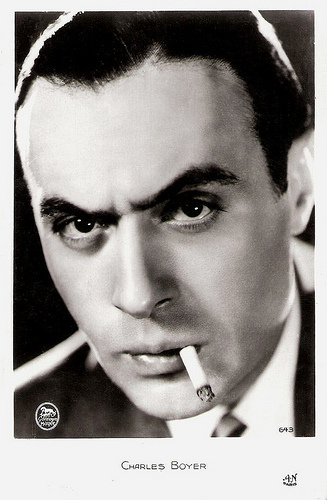
Charles Boyer . French postcard by A.N., Paris, no. 643. Photo: Metro Goldwyn Mayer.
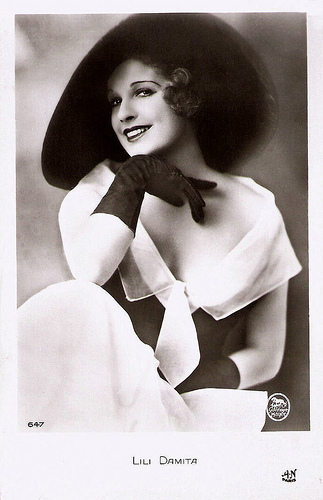
Lily Damita . French postcard by A.N., Paris, no. 647. Photo: Metro-Goldwyn-Mayer.
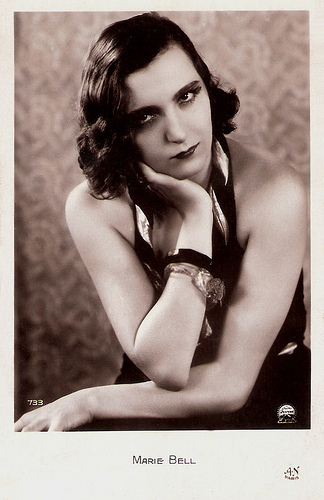
Marie Bell . French postcard by A.N., Paris, no. 733. Photo: Paramount.
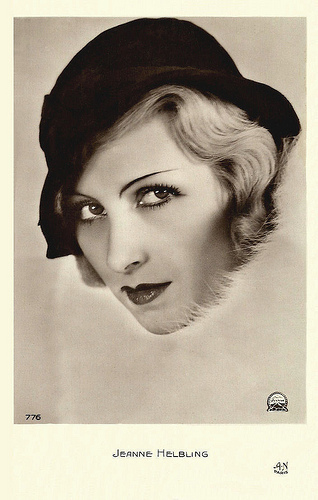
Jeanne Helbling . French postcard by A.N., Paris, no. 776. Photo: Paramount.
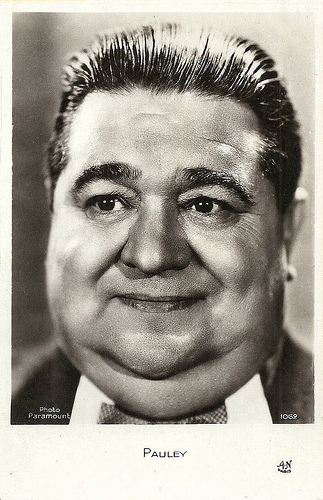
Pauley . French postcard by A.N., Paris, no. 1062. Photo: Paramount.

Jean Gabin . French postcard by A.N., Paris, no. 1160. Photo: Films Osso.
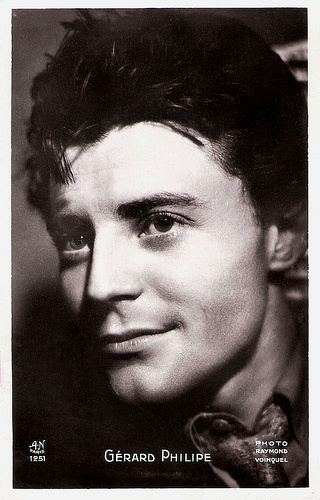
Gérard Philipe . French postcard by A.N., Paris, no. 1261. Photo: Raymond Voinquel.
This was the seventh post in a series on film star postcard publishers. Next week: Neue Photographische Gesellschaft (NPG). For earlier posts, see the links at right under the caption 'The Publishers'.
Sources: Metropolitan Postcard Club of New York City, Cinema Players Postal Antiquities, Georges Carpentier, The Idol of France, Helmut Schmidt (Boudoir Cards) and WikiBooks (French).

Stacia Napierkowska . French postcard by A.N., Paris, in the series Les Vedettes de Cinéma, no. 50. Photo: Sobol.

Raquel Meller . French postcard by A.N., Paris, in the series Les Vedettes de Cinéma, no. 51. Sent by mail in 1925. Photo: Sobol.

Charles de Rochefort . French postcard by A.N., Paris, in the series Les Vedettes de Cinéma, no. 77. Photo: Paramount Film.

Jean Angelo . French postcard by A.N., Paris, in the series Les Vedettes de Cinéma, no. 162. Photo: Sartony.

French postcard by A.N. Paris, in the series Les Vedettes de Cinéma, no. 251. Photo: Production Natan. Publicity still of Pierre Batcheff in Education de prince (Henri Diamant-Berger, 1927). Collection: Didier Hanson.
Armand Noyer
A.N. or A. Noyer stood for Armand Noyer, and not for Alfred Noyer, as many sources write. He was a well known French photographer in the early 20th Century. His company was located at the Boulevard de Strasbourg in Paris.
In the early 1910s, Noyer started to make postcards. Many of his early cards were photo reproductions of drawn, painted, or sculpted artworks printed in halftone lithography. Noyer was a member of the Salon de Paris and photographed paintings for the Salon and other institutions, which he also used for the production of his art cards.
Armand Noyer’s boldly hand colored seaside figures became his most recognized style. Many of his photos from this time were heavily toned in blue or sepia. Noyer also produced illustrated photo cards of the First World War, many with heavy patriotic or allegorical themes.

The novelist and performer Colette. French postcard by A.N. Paris, no. 22. Photo: Henri Manuel.

French boxer and war hero Georges Carpentier . French postcard by A.N., Paris. Collection: Didier Hanson.

Georges Carpentier. French postcard by A.N., Paris. Collection: Didier Hanson.

Miss Europe candidates 1930: the Misses Russia, Austria, and Holland. French postcard by A.N., Paris, no. 24. Left Irene Wentzel (aka Irene Wentzell aka Irina Veisel) was Miss Russia in Paris in 1930, elected by Russian immigrants, so she joined the 1930 Miss Europe pageant in Paris. Centre Ingeborg von Grinberger aka Grienberger was Miss Austria 1930, so she also joined the Miss Europe contest. Just like in 1929, the Austrian daily Das neue Wiener Tagblatt had organised the pageant. She originally came from the Austrian province of Steiermark. Most right is Rie van der Rest, the 1930 Miss Holland.

Miss Germany 1930: Dorit Nitykowski. French postcard by A.N., Paris, no. 5. Dorit Nitykowski, born 1911 in Berlin, was crowned Miss Germany in 1930 at the Berlin Kaiserhof. She could join the 1930 Miss Europe contest in Paris. Winner that year was Miss Greece: Aliki Diplarakou. Nitykowski also participated in the 1930 Miss Universe contest in Rio de Janeiro. She had to give back her title of Miss Germany, as she married the star pilot Rudolf Cramer von Clausbruch before her one-year existence of Miss Germany had ended.
Boudoir Cards
By the 1920s Armand Noyer began producing cards of children and women, many of which were nudes or risque images. Some sites call them 'boudoir cards', a popular genre since the Belle Epoque.
Noyer also published a widely distributed series of sepia-toned portrait postcards of boxer, war hero and incidental film actor Georges Carpentier , which all contain his signature. The series was produced by A.N. in the lead-up to Carpentier’s legendary fight in 1921 with champ Jack Dempsey. This fight for the world's heavyweight crown became one of the highlights of the Roaring Twenties.
Another example are the many postcards of Miss Europe contestants published by A.N. during the late 1920s and early 1930s.
We're of course especially interested in A.N. because it produced the exquisite series Les Vedettes de Cinema with sepia film star postcards. When the series stopped, A.N. continued to publish film star postcards. The numbering on the cards was continued.
Note that while many postcards carry his distinctive logo or his name, others are just marked A.N.
When and why A.N. stopped publishing postcards is unclear. If somebody has more information to share, please contact us.

Charles Boyer . French postcard by A.N., Paris, no. 643. Photo: Metro Goldwyn Mayer.

Lily Damita . French postcard by A.N., Paris, no. 647. Photo: Metro-Goldwyn-Mayer.

Marie Bell . French postcard by A.N., Paris, no. 733. Photo: Paramount.

Jeanne Helbling . French postcard by A.N., Paris, no. 776. Photo: Paramount.

Pauley . French postcard by A.N., Paris, no. 1062. Photo: Paramount.

Jean Gabin . French postcard by A.N., Paris, no. 1160. Photo: Films Osso.

Gérard Philipe . French postcard by A.N., Paris, no. 1261. Photo: Raymond Voinquel.
This was the seventh post in a series on film star postcard publishers. Next week: Neue Photographische Gesellschaft (NPG). For earlier posts, see the links at right under the caption 'The Publishers'.
Sources: Metropolitan Postcard Club of New York City, Cinema Players Postal Antiquities, Georges Carpentier, The Idol of France, Helmut Schmidt (Boudoir Cards) and WikiBooks (French).
Published on April 28, 2015 22:00
April 27, 2015
Asia Argento
Asia Argento (1975) is an Italian actress, singer, model, and director. She is the daughter of Giallo specialist Dario Argento and starred in several of her father’s films. She won several awards and starred in many international films.
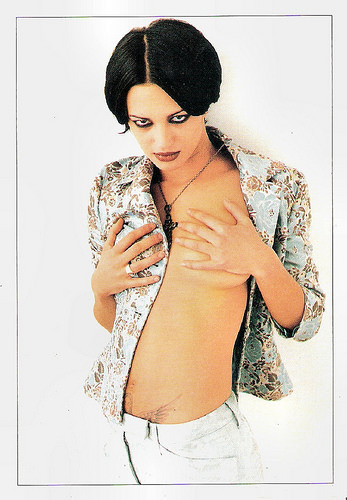
Italian postcard by CIAK. Photo: Giovanni Cozzi / TDR. Photo: publicity still for Viola bacia tutti/Viola Kisses Everybody (Giovanni Veronesi, 1998).
David di Donatello
Aria Asia Maria Vittoria Rossa Argento was born in 1975. Her mother is actress Daria Nicolodi and her father is Dario Argento, an Italian film director, producer and screenwriter, well known for his work in the Italian Giallo genre and for his influence on modern horror and slasher movies. Her maternal great-grandfather was composer Alfredo Casella.
When Asia Argento was born in Rome, the city registry office refused to acknowledge Asia as an appropriate name, and instead officially inscribed her as Aria Argento. As a child she was lonely and depressed, owing in part to her parents' work. At age eight, Argento published a book of poems, and at the age of 14, she ran away from home.
She also started acting at the age of nine, playing a small role in the TV Miniseries Sogni e bisogni/Dreams and needs (Sergio Citti, 1985), starring Giulietta Masina . Two years later, she had a small part in Dèmoni 2/Demons 2 (Lamberto Bava, 1986), which was written and produced by her father. She also appeared in its sequel, the horror film La Chiesa/The Church (Michele Soavi, 1989), when she was 14. It was produced by Dario Argento with Mario and Vittorio Cecchi Gori.
Her next film was the teen drama Le amiche del cuore/Close Friends (Michele Placido, 1992), which was entered into the Quinzaine des Réalisateurs section at the 1992 Cannes Film Festival.
When she was 18, Argento starred in her father’s Giallo Trauma (Dario Argenta, 1993) about murders in a psychiatric hospital. The character played by Asia was inspired by her half-sister Anna (Nicolodi's daughter from a previous marriage) who suffered from anorexia like Asia’s character in the film. Trauma was Dario Argento's first feature length American production and the cast featured American actors like Piper Laurie, Frederic Forrest and Brad Dourif.
Asia received the David di Donatello (Italy's version of the Academy Award) for Best Actress in 1994 for her performance in the comedy Perdiamoci di vista/Let's Not Keep in Touch (1993) written, directed and starred by Carlo Verdone. She won another David di Donatello for her role opposite Michel Piccoli in Compagna di viaggio/Traveling Companion (Peter Del Monte, 1996), which also earned her a Grolla d'oro award.
A large box office hit when released in Italy was the horror film La Sindrome di Stendhal/The Stendhal Syndrome (Dario Argento, 1995), starring Asia opposite Thomas Kretschmann. La Sindrome di Stendhal was the first Italian film to use computer-generated imagery (CGI). It was Dario Argento's highest grossing film in Italy.
Trailer Trauma (1993). Source: R6dw6C (YouTube).
Calling the Shots
Asia Argento has proven her ability to work in multiple languages.
In France, she played the supporting role of Charlotte de Sauve in the period film La Reine Margot/Queen Margot (Patrice Chéreau, 1994), starring Isabelle Adjani . The film was an international box-office success, and won the Jury Prize and Best Actress Award at the 1994 Cannes Film Festival, as well as five César Awards.
Later French films with her were the thriller La sirène rouge/The Red Siren (Olivier Megaton, 2002) with Jean-Marc Barr, the drama Transylvania (Tony Gatlif, 2006) and the thriller Boarding Gate (Olivier Asayas, 2008) with Michael Madsen.
In 1998, Asia Argento began appearing in English-language films, such as the crime film B. Monkey (Michael Radford, 1998), opposite Jared Harris and Rupert Everett , and the Cyberpunk film New Rose Hotel (Abel Ferrara, 1998) with Christopher Walken and Willem Dafoe.
That same year, she made her first foray into directing, calling the shots behind the short films Prospettive and A ritroso. In 1996, she had directed a documentary on her father, and in 1998 she directed a second one on Abel Ferrara, which won her the Rome Film Festival Award.
She also starred with Julian Sands in her father’s Il fantasma dell'opera/The Phantom of the Opera (Dario Argento, 1998), adapted from the novel Le Fantôme de l'Opéra by Gaston Leroux, although there are many differences between the book and the film (the biggest: the Phantom is not disfigured).
Trailer Scarlet Diva (2000). Source: Film&Clips (YouTube).
Scarlet Diva
In 2000, Asia Argento directed and wrote her first feature film, the semi-autobiographical Scarlet Diva (2000), in which she also starred. It was a family affair. Her mother, Daria Nicolodi, played Asia’s character’s mother, her uncle Claudia Argento produced the film and her father co-produced.
Four years later she directed her second film, The Heart Is Deceitful Above All Things (2004), in which she starred with Peter Fonda as her father and Ornella Muti as her mother.
In the US, she starred in the action film xXx (Rob Cohen, 2002) with Vin Diesel and Samuel L. Jackson, which was a commercial success. Other films in which she starred were The Keeper (2004, Paul Lynch) with Dennis Hopper, Last Days (Gus Van Sant, 2005) starring Michael Pitt, and George A. Romero's post-apocalyptic horror film Land of the Dead (2005).
She played Madame DuBarry in the historical drama Marie Antoinette (2006), written and directed by Sofia Coppola. Argento reunited with Abel Farrara for Go Go Tales (Abel Ferrara, 2007) starring Willem Dafoe.
In France she appeared in Une vieille maîtresse/The Last Mistress (Catherine Breillat, 2007), based on a controversial novel by the French writer Jules Amédée Barbey d'Aurevilly. The film was entered into the 2007 Cannes Film Festival.
Then followed a starring role in her father’s supernatural horror film La Terza madre/The Mother of Tears (Dario Argento, 2007) with her mother Daria Nicolodi and Udo Kier co-starring. La Terza madre is the concluding instalment of Argento's supernatural horror trilogy The Three Mothers, which began with Suspiria in 1977.
More recent films include the Italian drama Isole/Islands (Stefano Chiantini, 2011), the comedy Baciato dalla fortuna (Paolo Costella, 2011) – a huge hit in Italy, and Dracula 3D (Dario Argento, 2012) starring Thomas Kretschmann and Rutger Hauer .
In addition to her cinematic accomplishments, Argento has written a number of stories for magazines, while her first novel, titled I Love You Kirk, was published in Italy in 1999. She has modelled for and endorses the brand Miss Sixty. She became a fan of the band Hondo Maclean when they wrote a track named after her. She liked the track so much she sent them pictures which they used as the cover of their 2003 EP Plans for a better day.
Her first child, Anna Lou, was born in 2001. Italian rock and roll musician Marco Castoldi (lead singer of Bluvertigo), also known as Morgan, is the father. She named her daughter after her half-sister Anna Ceroli, who died in a motorcycle accident. Argento married film director Michele Civetta in 2008 in Arezzo. Her second child, Nicola Giovanni, was born that year in Rome.
Trailer Dracula 3D (2012). Source: JoBlo Movie Trailers (YouTube).
Sources: Wikipedia and .

Italian postcard by CIAK. Photo: Giovanni Cozzi / TDR. Photo: publicity still for Viola bacia tutti/Viola Kisses Everybody (Giovanni Veronesi, 1998).
David di Donatello
Aria Asia Maria Vittoria Rossa Argento was born in 1975. Her mother is actress Daria Nicolodi and her father is Dario Argento, an Italian film director, producer and screenwriter, well known for his work in the Italian Giallo genre and for his influence on modern horror and slasher movies. Her maternal great-grandfather was composer Alfredo Casella.
When Asia Argento was born in Rome, the city registry office refused to acknowledge Asia as an appropriate name, and instead officially inscribed her as Aria Argento. As a child she was lonely and depressed, owing in part to her parents' work. At age eight, Argento published a book of poems, and at the age of 14, she ran away from home.
She also started acting at the age of nine, playing a small role in the TV Miniseries Sogni e bisogni/Dreams and needs (Sergio Citti, 1985), starring Giulietta Masina . Two years later, she had a small part in Dèmoni 2/Demons 2 (Lamberto Bava, 1986), which was written and produced by her father. She also appeared in its sequel, the horror film La Chiesa/The Church (Michele Soavi, 1989), when she was 14. It was produced by Dario Argento with Mario and Vittorio Cecchi Gori.
Her next film was the teen drama Le amiche del cuore/Close Friends (Michele Placido, 1992), which was entered into the Quinzaine des Réalisateurs section at the 1992 Cannes Film Festival.
When she was 18, Argento starred in her father’s Giallo Trauma (Dario Argenta, 1993) about murders in a psychiatric hospital. The character played by Asia was inspired by her half-sister Anna (Nicolodi's daughter from a previous marriage) who suffered from anorexia like Asia’s character in the film. Trauma was Dario Argento's first feature length American production and the cast featured American actors like Piper Laurie, Frederic Forrest and Brad Dourif.
Asia received the David di Donatello (Italy's version of the Academy Award) for Best Actress in 1994 for her performance in the comedy Perdiamoci di vista/Let's Not Keep in Touch (1993) written, directed and starred by Carlo Verdone. She won another David di Donatello for her role opposite Michel Piccoli in Compagna di viaggio/Traveling Companion (Peter Del Monte, 1996), which also earned her a Grolla d'oro award.
A large box office hit when released in Italy was the horror film La Sindrome di Stendhal/The Stendhal Syndrome (Dario Argento, 1995), starring Asia opposite Thomas Kretschmann. La Sindrome di Stendhal was the first Italian film to use computer-generated imagery (CGI). It was Dario Argento's highest grossing film in Italy.
Trailer Trauma (1993). Source: R6dw6C (YouTube).
Calling the Shots
Asia Argento has proven her ability to work in multiple languages.
In France, she played the supporting role of Charlotte de Sauve in the period film La Reine Margot/Queen Margot (Patrice Chéreau, 1994), starring Isabelle Adjani . The film was an international box-office success, and won the Jury Prize and Best Actress Award at the 1994 Cannes Film Festival, as well as five César Awards.
Later French films with her were the thriller La sirène rouge/The Red Siren (Olivier Megaton, 2002) with Jean-Marc Barr, the drama Transylvania (Tony Gatlif, 2006) and the thriller Boarding Gate (Olivier Asayas, 2008) with Michael Madsen.
In 1998, Asia Argento began appearing in English-language films, such as the crime film B. Monkey (Michael Radford, 1998), opposite Jared Harris and Rupert Everett , and the Cyberpunk film New Rose Hotel (Abel Ferrara, 1998) with Christopher Walken and Willem Dafoe.
That same year, she made her first foray into directing, calling the shots behind the short films Prospettive and A ritroso. In 1996, she had directed a documentary on her father, and in 1998 she directed a second one on Abel Ferrara, which won her the Rome Film Festival Award.
She also starred with Julian Sands in her father’s Il fantasma dell'opera/The Phantom of the Opera (Dario Argento, 1998), adapted from the novel Le Fantôme de l'Opéra by Gaston Leroux, although there are many differences between the book and the film (the biggest: the Phantom is not disfigured).
Trailer Scarlet Diva (2000). Source: Film&Clips (YouTube).
Scarlet Diva
In 2000, Asia Argento directed and wrote her first feature film, the semi-autobiographical Scarlet Diva (2000), in which she also starred. It was a family affair. Her mother, Daria Nicolodi, played Asia’s character’s mother, her uncle Claudia Argento produced the film and her father co-produced.
Four years later she directed her second film, The Heart Is Deceitful Above All Things (2004), in which she starred with Peter Fonda as her father and Ornella Muti as her mother.
In the US, she starred in the action film xXx (Rob Cohen, 2002) with Vin Diesel and Samuel L. Jackson, which was a commercial success. Other films in which she starred were The Keeper (2004, Paul Lynch) with Dennis Hopper, Last Days (Gus Van Sant, 2005) starring Michael Pitt, and George A. Romero's post-apocalyptic horror film Land of the Dead (2005).
She played Madame DuBarry in the historical drama Marie Antoinette (2006), written and directed by Sofia Coppola. Argento reunited with Abel Farrara for Go Go Tales (Abel Ferrara, 2007) starring Willem Dafoe.
In France she appeared in Une vieille maîtresse/The Last Mistress (Catherine Breillat, 2007), based on a controversial novel by the French writer Jules Amédée Barbey d'Aurevilly. The film was entered into the 2007 Cannes Film Festival.
Then followed a starring role in her father’s supernatural horror film La Terza madre/The Mother of Tears (Dario Argento, 2007) with her mother Daria Nicolodi and Udo Kier co-starring. La Terza madre is the concluding instalment of Argento's supernatural horror trilogy The Three Mothers, which began with Suspiria in 1977.
More recent films include the Italian drama Isole/Islands (Stefano Chiantini, 2011), the comedy Baciato dalla fortuna (Paolo Costella, 2011) – a huge hit in Italy, and Dracula 3D (Dario Argento, 2012) starring Thomas Kretschmann and Rutger Hauer .
In addition to her cinematic accomplishments, Argento has written a number of stories for magazines, while her first novel, titled I Love You Kirk, was published in Italy in 1999. She has modelled for and endorses the brand Miss Sixty. She became a fan of the band Hondo Maclean when they wrote a track named after her. She liked the track so much she sent them pictures which they used as the cover of their 2003 EP Plans for a better day.
Her first child, Anna Lou, was born in 2001. Italian rock and roll musician Marco Castoldi (lead singer of Bluvertigo), also known as Morgan, is the father. She named her daughter after her half-sister Anna Ceroli, who died in a motorcycle accident. Argento married film director Michele Civetta in 2008 in Arezzo. Her second child, Nicola Giovanni, was born that year in Rome.
Trailer Dracula 3D (2012). Source: JoBlo Movie Trailers (YouTube).
Sources: Wikipedia and .
Published on April 27, 2015 22:00
Paul van Yperen's Blog
- Paul van Yperen's profile
- 13 followers
Paul van Yperen isn't a Goodreads Author
(yet),
but they
do have a blog,
so here are some recent posts imported from
their feed.



